Physical Address
304 North Cardinal St.
Dorchester Center, MA 02124
Fractures of the olecranon and coronoid processes occur in patterns that can help guide management. There are anterior and posterior olecranon-fracture dislocations and varus posteromedial pattern injuries. The eponym Monteggia is best reserved for forearm fracture dislocations, where fractures of the proximal ulnar diaphysis occur with dislocation of the proximal radioulnar joint.
As with other traumatic injuries, the first step in management is to perform a thorough evaluation according to the Advanced Trauma Life Support guidelines. Most fractures of the proximal ulna are associated with low-energy falls in older patients. Such patients should be evaluated for medical conditions that may have contributed to the fall, for injuries related to older age (e.g., other osteoporosis-related fractures, subdural hematoma), and for the effect the injury may have on their social situation (i.e., whether they will be able to live independently while recovering).
The elbow should be checked for wounds and neurovascular injury. Anterior and lateral Monteggia fractures can be associated with injury to the posterior interosseous nerve. High-energy complex fractures of the proximal ulna are occasionally associated with forearm compartment syndrome, especially when there is another fracture of the wrist or forearm.
It can be difficult to obtain quality radiographs of the injury initially due to deformity and pain in the limb. Look for clues on the radiographs that help discern the overall pattern of the injury. For example, fracture of the radial head indicates a posterior olecranon fracture-dislocation, which is often associated with fragmentation of the coronoid process and avulsion of the origin of the lateral collateral ligament complex from the lateral epicondyle. Anterior olecranon fracture-dislocations rarely involve injury to the radial head or collateral ligaments.
Most injuries will require operative intervention. Immediate reduction is only necessary if there is pressure on the skin or a nerve, or perhaps if there is bone protruding through a wound. Otherwise, the limb can be splinted without reduction, and there is no time constraint to planning the surgery. Radiographs obtained after manipulative reduction and splint immobilization of the limb may provide better views of the elbow and additional information about the injury but are not necessary ( Fig. 20.1A and B ). When additional information about fractures of the radial head or coronoid may influence decision making, computed tomography (CT) is useful (see Fig. 20.1C ). In particular, three-dimensional reconstructions with the distal humerus removed can provide a very accurate characterization of the bony injury (see Fig. 20.1D and E ). Use of such images makes the preoperative planning more accurate.
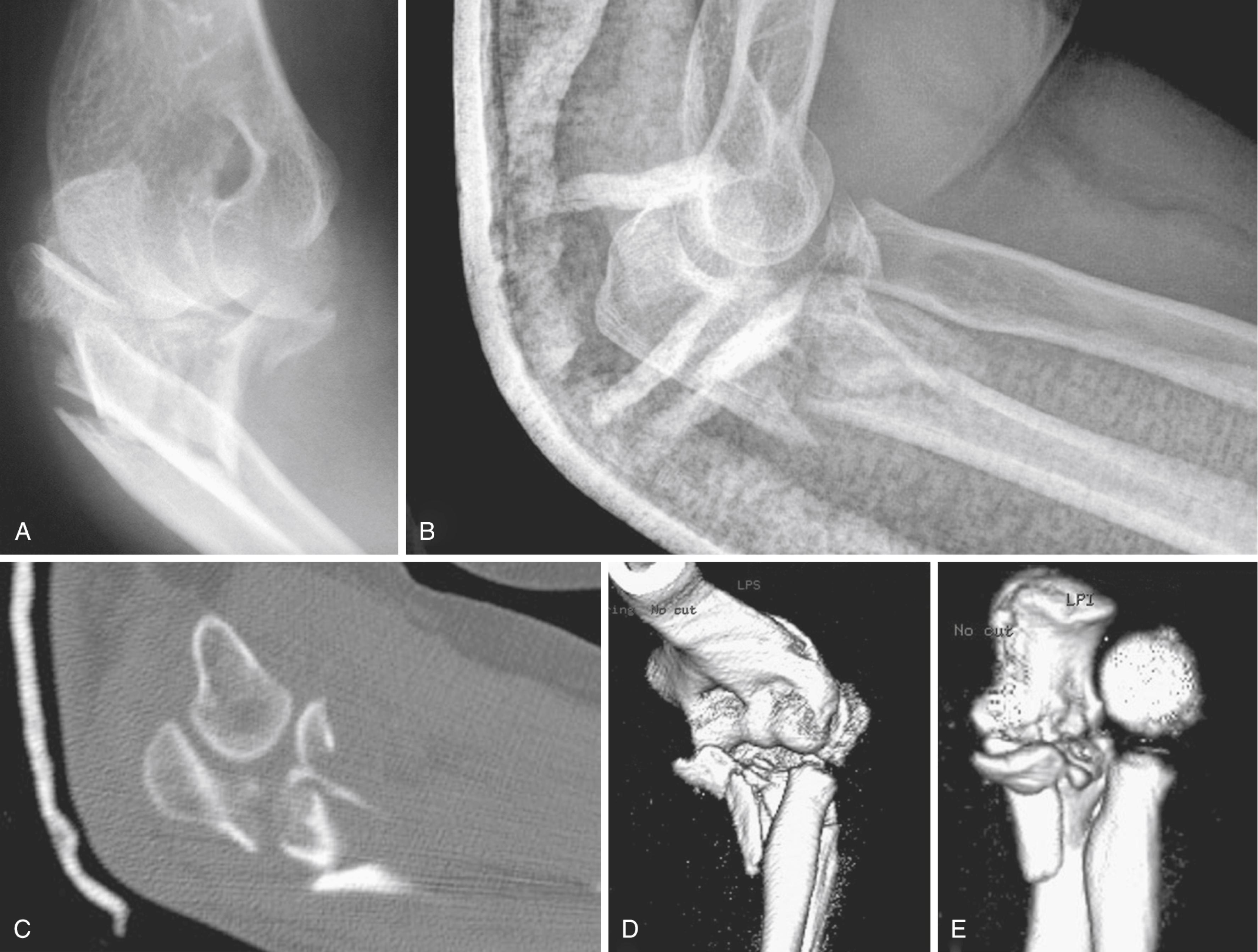
Additional information regarding the character of the injury can be obtained by viewing the elbow under the image intensifier once the patient is anesthetized. For some complex injuries, complete characterization of the injury pattern—and, therefore, a final treatment plan—can only be made after the injury is exposed operatively. One must be prepared to extend exposures as needed to provide adequate access to all of the injury components.
The trochlear notch of the ulna has a circumference of nearly 180 degrees, making it one of the most inherently constrained human articulations. Further enhancements of stability include (1) a central longitudinal ridge that interdigitates with a groove in the trochlear articular surface of the distal humerus and (2) a posterior tilt of the articular surface, with the angle between the tip of the coronoid and olecranon processes subtending approximately 30 degrees with a line parallel to the ulnar shaft ( Fig. 20.2 ). There is a complementary anterior offset of the trochlea of the humerus from the shaft that permits the ulnohumeral joint to flex to 140 degrees.
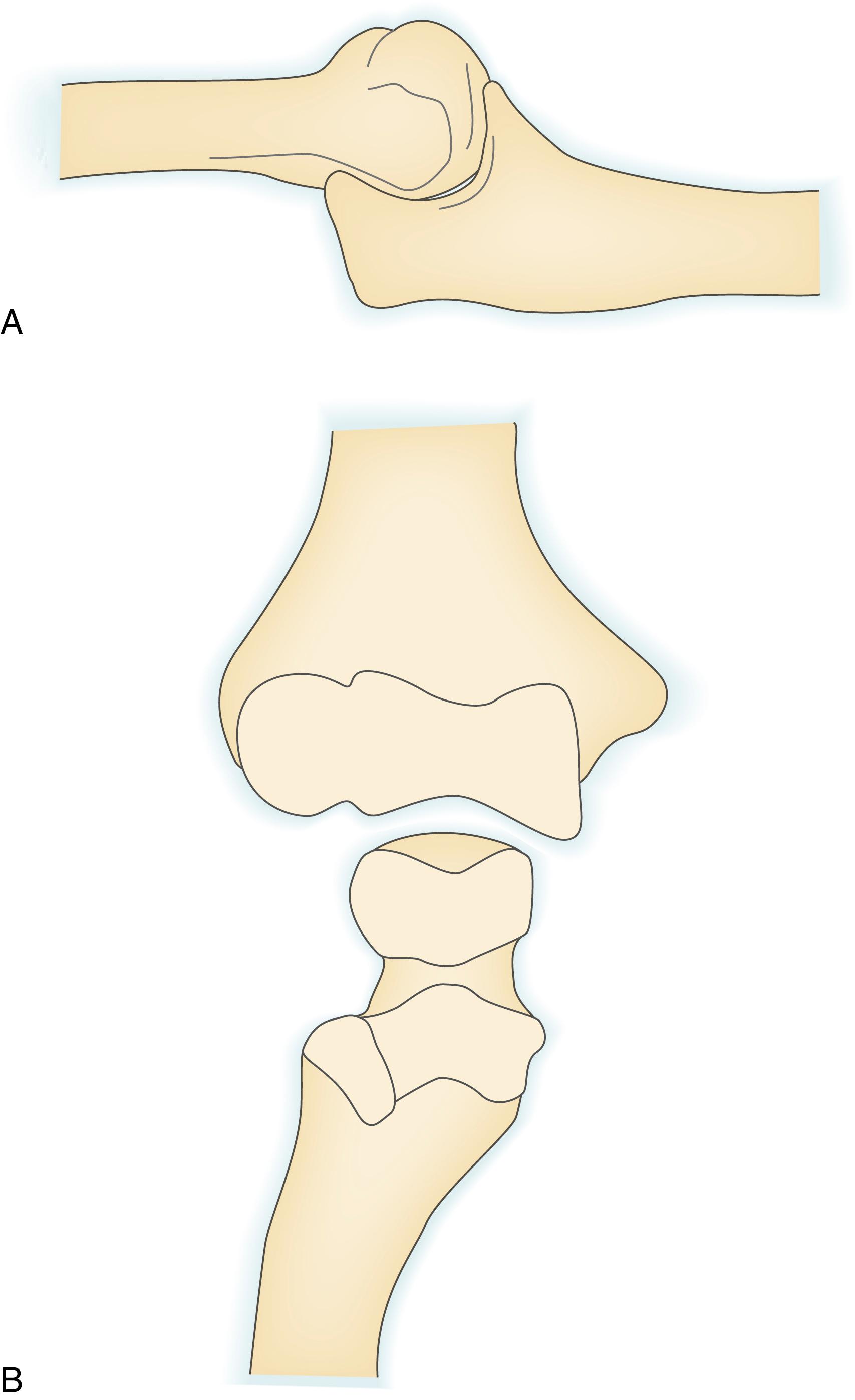
The articular surface has separate coronoid and olecranon areas separated by a small nonarticular transverse groove (see Fig. 20.2B ). , Consequently, the treatment of articular fractures of the trochlear notch should focus primarily on restoring the proper relationship between the coronoid and olecranon processes. ,
It is useful to consider the following areas of the coronoid articular surface: the anteromedial facet, the lesser sigmoid notch region, the tip, and the base. The anteromedial facet, in particular, is now recognized as a stabilizer of the elbow under varus and rotational stress. , ,
The soft tissue attachments to the coronoid also figure prominently in the understanding of proximal ulnar fractures ( Fig. 20.3 ). The anterior band of the medial collateral ligament inserts on the base of the coronoid process. Consequently, the anterior band of the medial collateral ligament is likely to be intact in complex fractures associated with large fractures of the coronoid base or anteromedial coronoid fractures. Its function will be disrupted by the bony injury and restored with stable internal fixation. ,
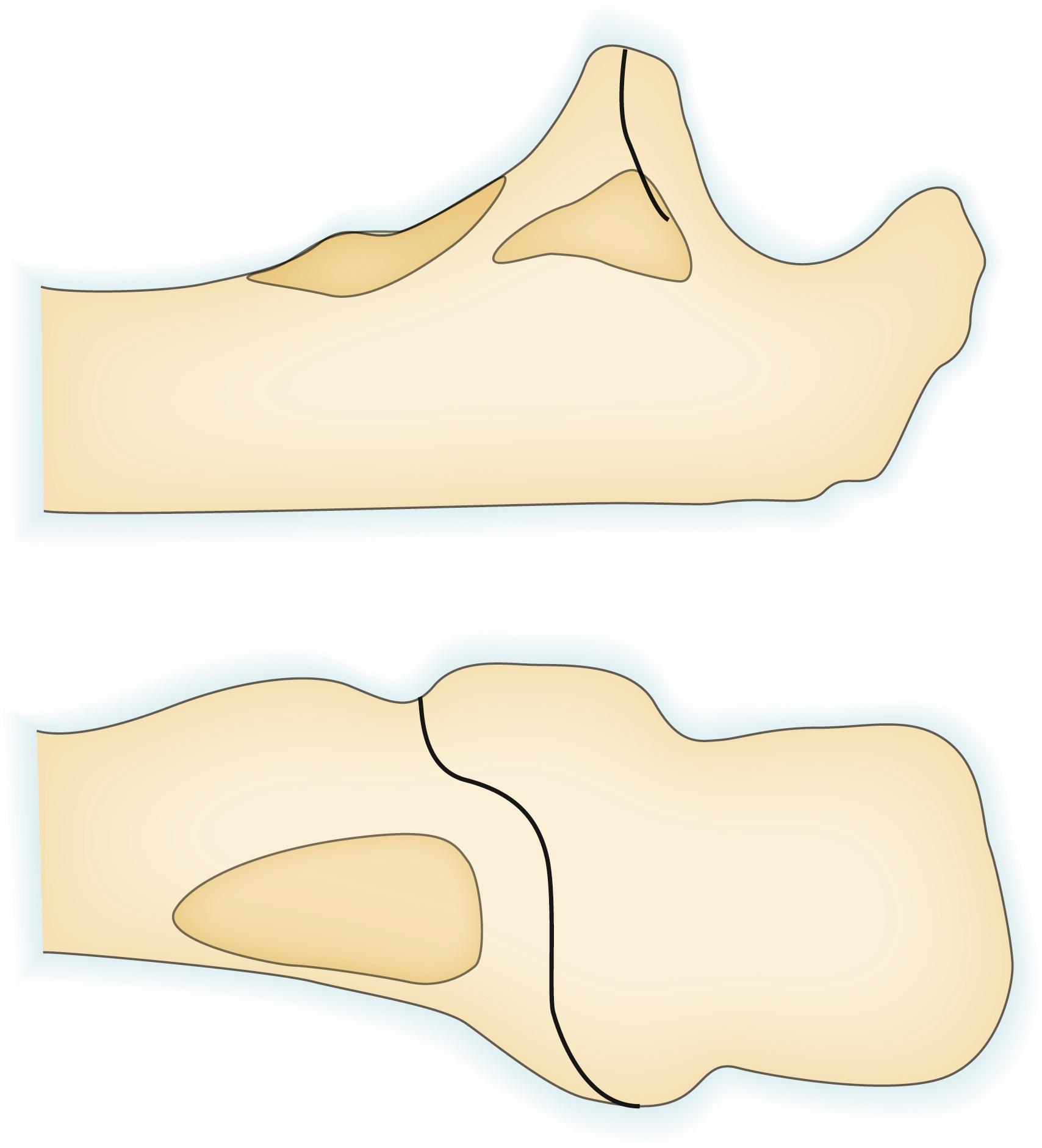
The brachialis has a broad insertion that extends distal to the coronoid process. Even with large coronoid fractures, a substantial portion of the brachialis insertion remains on the ulnar shaft.
The lateral collateral ligament complex has a broad insertion on the lateral ulna below the radial head and neck and below the level of most coronoid fractures. Dislocation of the elbow nearly always results in avulsion of its origin from the lateral epicondyle and not as an intrasubstance tear or avulsion from the ulna. An interesting and uncommon variation is avulsion fracture of the insertion of the lateral collateral ligament into the crista supinatoris.
The anterior capsule inserts a few millimeters below the tip of the olecranon process. This has been interpreted to mean that very small coronoid fractures (a simple fleck, according to Regan and Morrey ) may represent intraarticular free fragments; however, operative treatment of these injuries discloses that coronoid tip fractures are much larger than might be guessed based on radiographs and that they always include the capsular insertion.
The junction of the olecranon process with the proximal ulnar metaphysis occurs at the transverse groove of the olecranon, which is a nonarticular area with consequently less subchondral bone. This is also a relatively narrow area in the sagittal plane. These factors may increase the susceptibility to fracture at this site.
The triceps has a very broad and thick insertion onto the posterior and proximal aspects of the olecranon. This is notable during the application of a plate that contours around this portion of the bone: if the center of the triceps insertion is not split and elevated from the bone, the proximal aspect of the plate will rest well off the bone. For complex olecranon fractures, this situation may sometimes be preferable to additional dissection of the soft tissue attachments.
The anatomy of the radial head is difficult to replicate with a prosthesis. It has a slightly elliptical cross section and interdigitates precisely with both the lesser sigmoid notch and the lateral lip of the trochlea, not to mention the capitellar articular surface. The slight angulation of the proximal radius with respect to the shaft further complicates attempts to reconstruct or replace the radius.
When plates are used to repair the radial head, several anatomic features are important. First, the posterior interosseous nerve runs deep to the supinator along the lateral aspect of the radial neck and is therefore at risk during operative dissection and implant application. Full pronation provides an average of approximately 5 cm of safe area for dissection and internal fixation, but this is not the usual position for internal fixation, and it may be safest to routinely expose the nerve when very distal dissection is needed at and past the bicipital tuberosity.
Second, the radial head has a relatively small nonarticular surface, so implants placed on the articular surface must be countersunk. This is possible with plates as well as screws. The nonarticular area can be determined as an arc of roughly 90 degrees with its midpoint directly lateral with the arm in neutral position, with a slightly greater margin anteriorly. As a rough guide to this area, the area between the Lister tubercle and the radial styloid on the distal radius has been suggested.
Finally, the vascular supply to the radial head is limited and tenuous. This may be one reason for the occasional nonunions observed after both operative and nonoperative treatment.
Most elbow dislocations are associated with avulsion of the origins of the medial and lateral collateral ligaments and some of the common flexor and extensor origins from the medial and lateral epicondyles. Recurrent elbow dislocation is usually related to lateral collateral ligament insufficiency.
The notch formed by the coronoid and olecranon processes provides stability in the sagittal plane. The extension of the coronoid medially and the radial head laterally enhance stability in the coronal plane and under rotational stress. , Even small fractures of the coronoid can be associated with subluxation or dislocation of the elbow. Anteromedial facet coronoid fractures are associated with subluxation of the elbow, particularly when the lateral collateral ligament is avulsed from the lateral epicondyle. Fractures of the tip of the coronoid associated with concomitant fracture of the radial head and elbow dislocation (ligament injuries) are prone to repeat dislocation or subluxation. , , ,
The injury originally described by Monteggia is a forearm fracture-dislocation: fracture of the ulnar shaft with dislocation of the proximal radioulnar joint. , The angulation of the fracture and displacement of the radial head is anterolateral. The key element of treatment is stable restoration of ulnar alignment with a plate and screws, which nearly always restores alignment and function of the proximal radioulnar joint. , ,
Extraarticular fracture of the proximal ulna metaphysis distal to the coronoid, with posterior radiocapitellar subluxation and—in most cases—fracture of the radial head, is sometimes referred to as a posterior Monteggia lesion, , but this grouping is confusing because the radioulnar relationship is maintained. As suggested by Jupiter and colleagues, this injury pattern has more in common with posterior olecranon fracture-dislocations ( Fig. 20.4 ). Treatment consists of realignment of the ulna, plate and screw fixation, and selective repair or replacement of the fractured radial head, with occasional reattachment of lateral collateral ligament avulsion from the epicondyle.
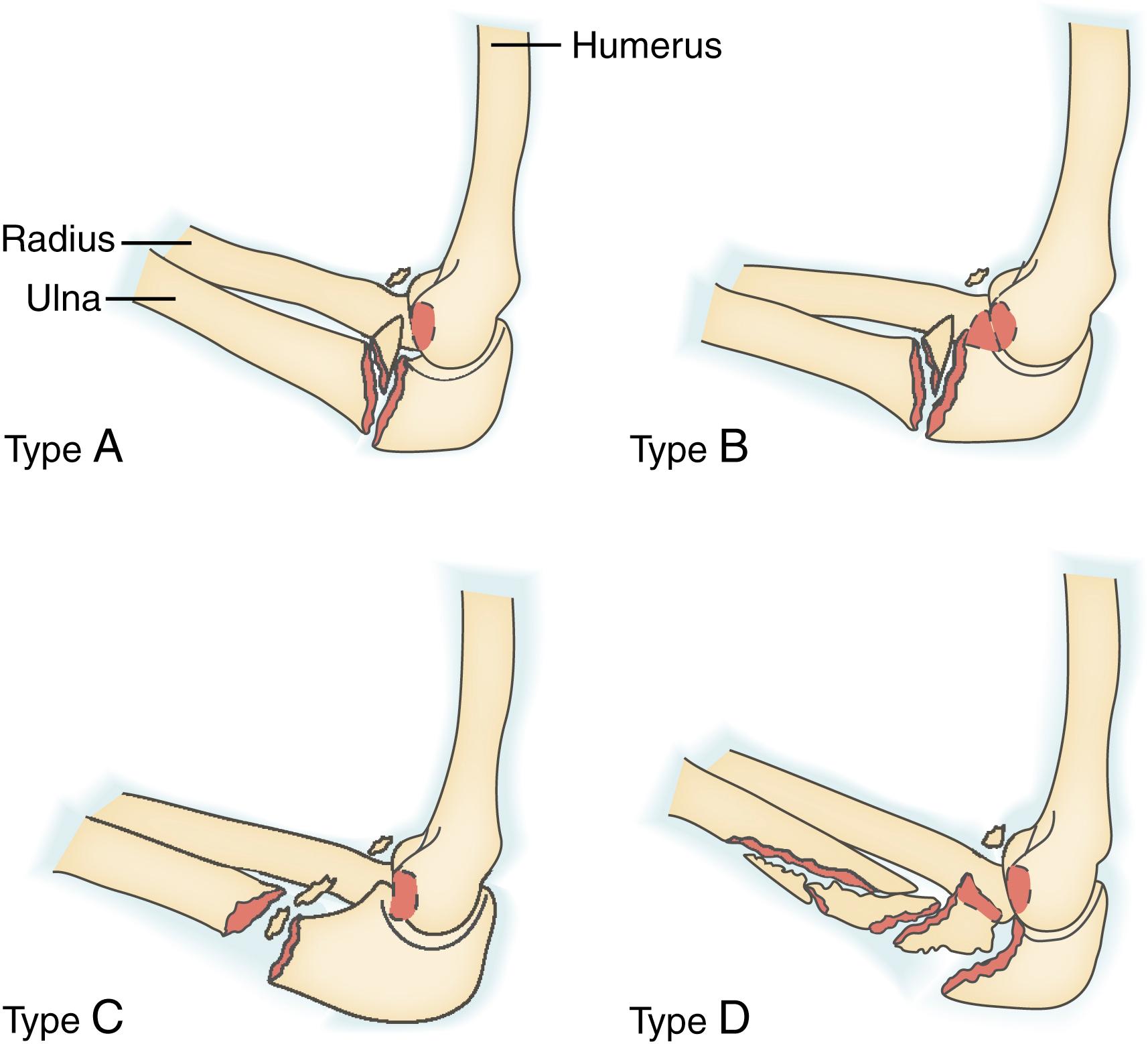
The Mayo classification of olecranon fractures distinguishes three factors that have a direct influence on treatment: (1) displacement, (2) fragmentation, and (3) ulnohumeral joint subluxation ( Fig. 20.5 ). Type I fractures are the uncommon nondisplaced or minimally displaced fractures that are treated nonoperatively. Type II fractures are displaced and either simple (IIA) or fragmented (IIB). Nonfragmented fractures can be treated with a screw, wires, or suture. Fragmented fractures are repaired with a plate and screws. Type III fractures are injuries with anterior, posterior, or varus subluxation of the forearm relative to the distal humerus.
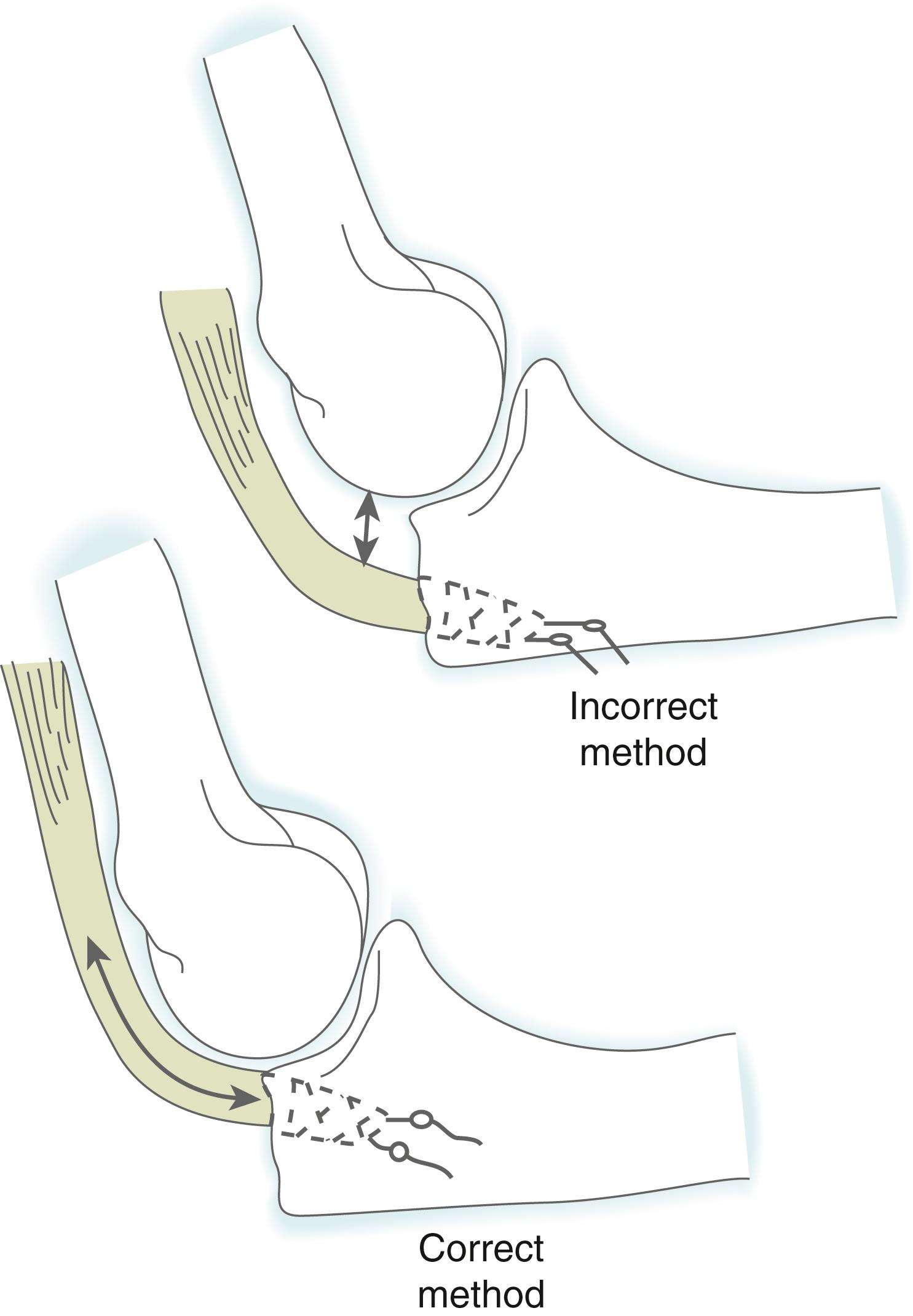
On rare occasions, a simple elbow dislocation or terrible triad injury is associated with a fracture of the olecranon ( Fig. 20.6 and Case Study 20.1 ). The pattern of olecranon fracture may represent a bony alternative to rupture of the medial collateral ligament complex. Most traumatic elbow instability featuring fracture of the olecranon does not involve complete loss of apposition of the articular surfaces (true dislocation), and the ligaments are typically relatively intact. Anterior (transolecranon) olecranon fracture-subluxations are often caused by a high-energy direct blow to the forearm. , The proximal ulnar fracture is often fragmented; the coronoid—when fractured—is typically fractured at the base, creating one or perhaps two large fragments ( Case Study 20.2 ). The forearm translates anteriorly with respect to the distal humerus, and the proximal radioulnar relationship is maintained ( Fig. 20.7 ). , , Associated collateral ligament injury is unusual, , and the elbow is typically rendered stable once the coronoid and olecranon relationships are restored and stabilized with a plate and screws.
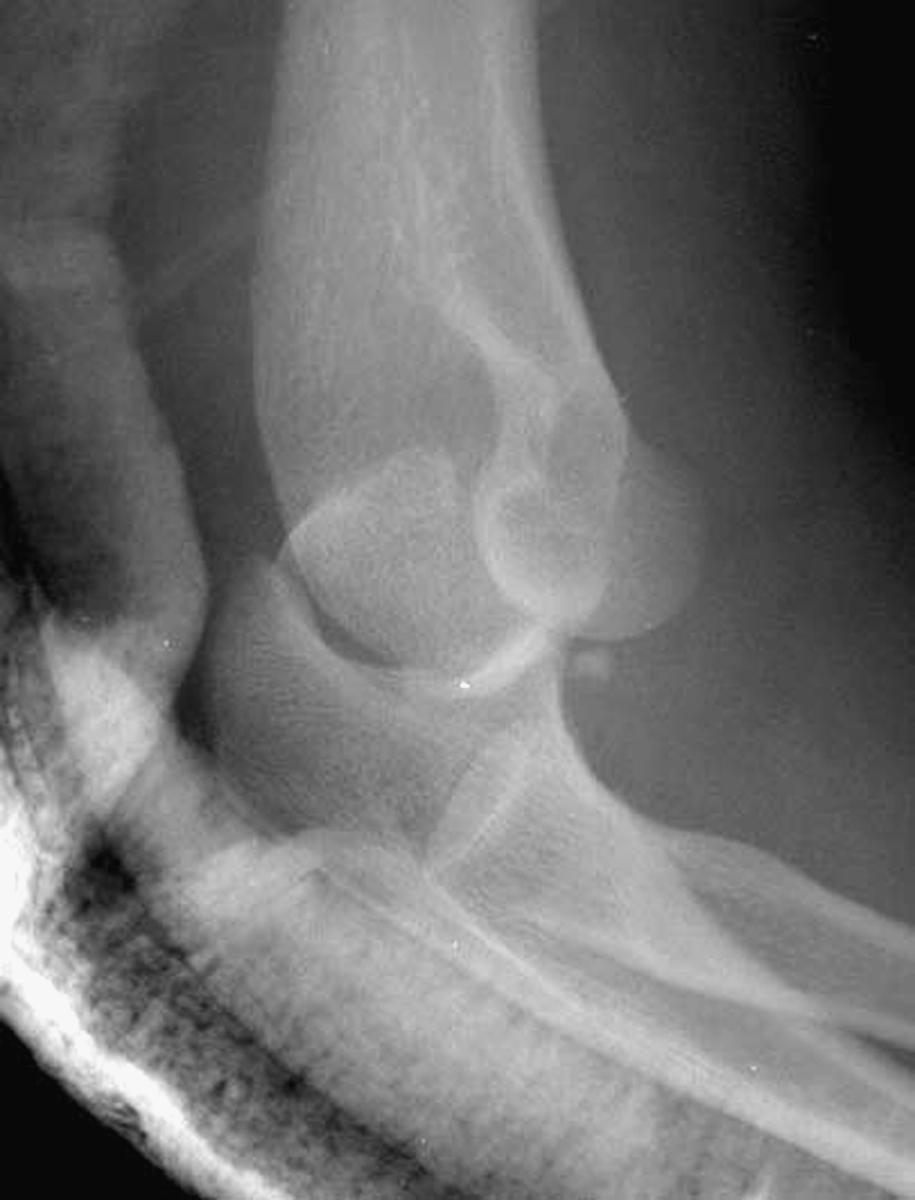
FLOAT NOT FOUND FLOAT NOT FOUND

In this unusual case, a patient has sustained a posterior dislocation of the elbow associated with a fracture of the olecranon process on the medial aspect, essentially avulsing the posterior aspect of the medial collateral ligament complex ( eFig. 20.1 ). FLOAT NOT FOUND
The surgical procedure is displayed in eFig. 20.2 , and the results are shown in eFig. 20.3 . FLOAT NOT FOUND FLOAT NOT FOUND
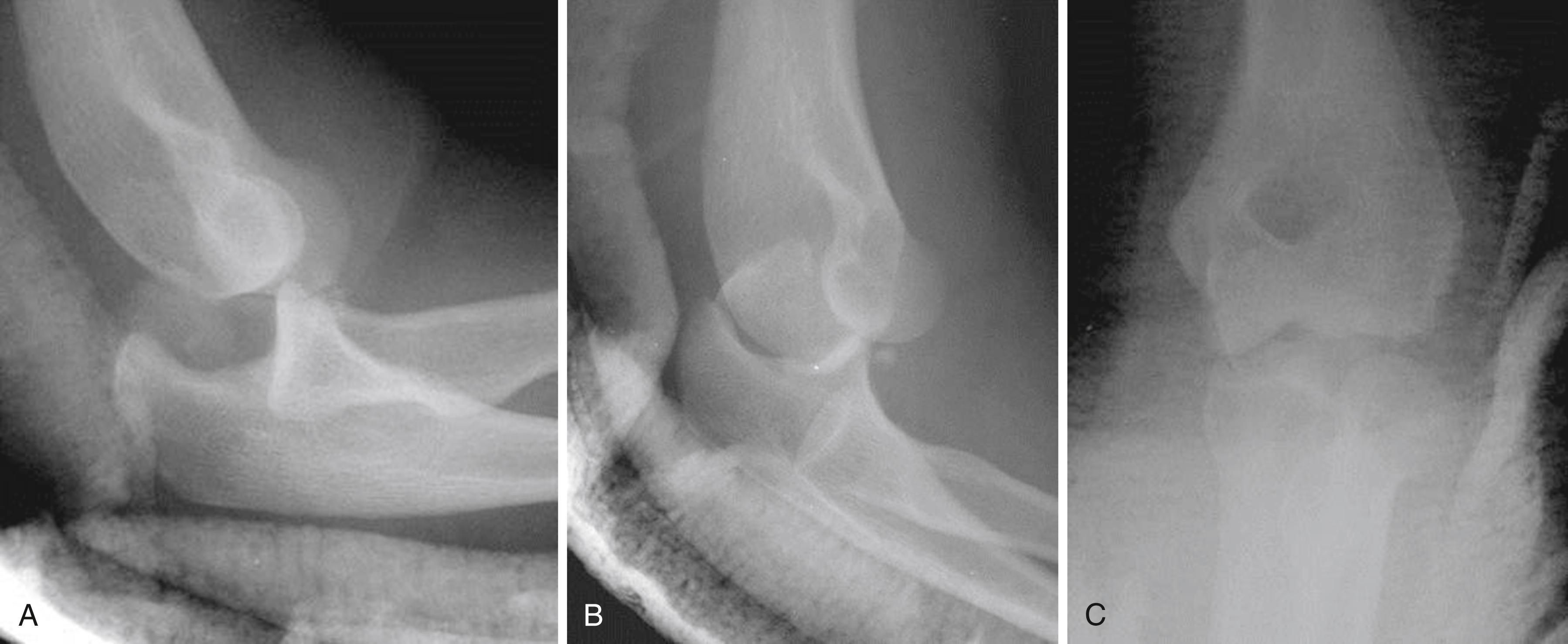
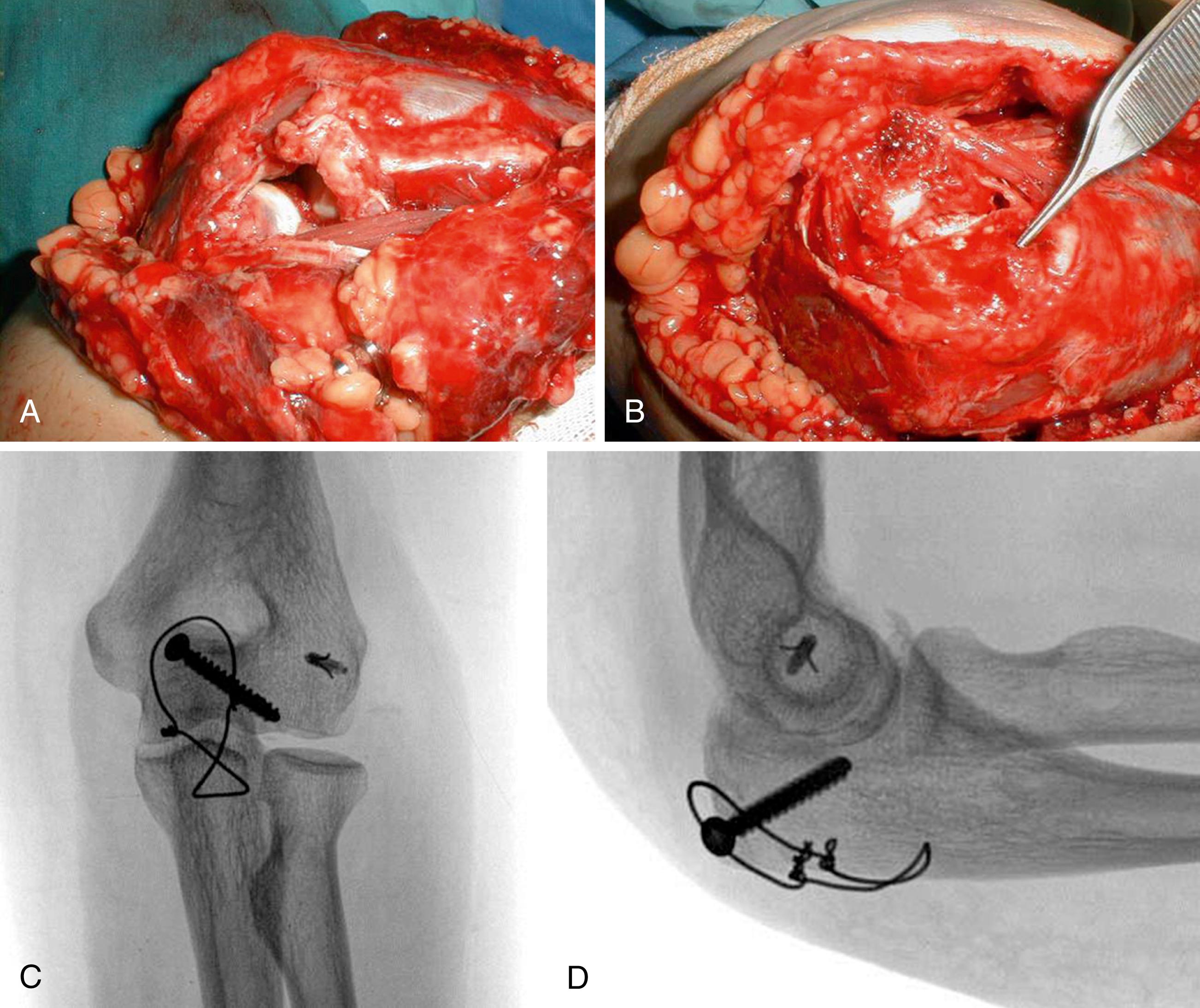
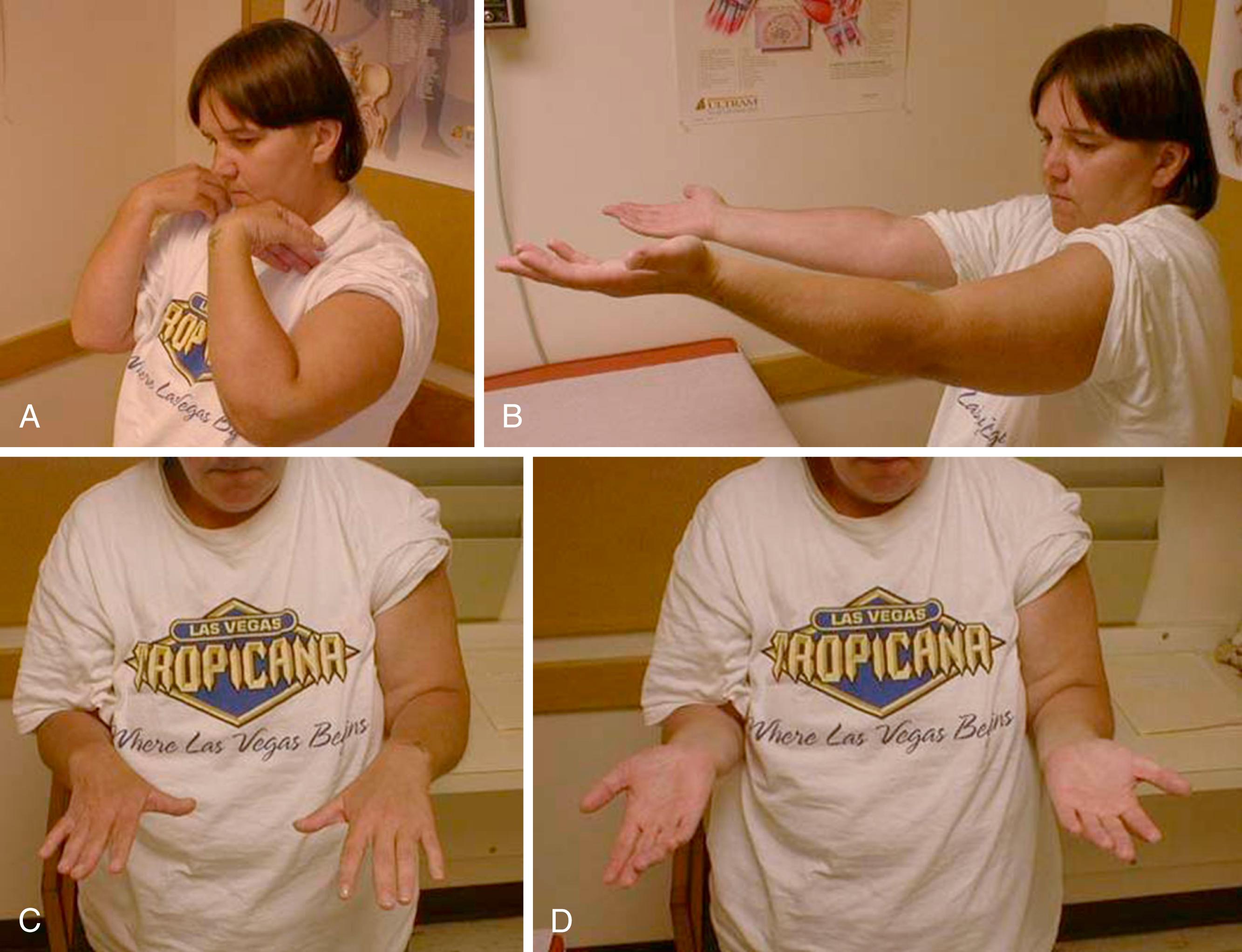
The patient presented with an anterior fracture-subluxation of the elbow ( eFig. 20.4 ). FLOAT NOT FOUND
The surgical procedure is displayed in eFig. 20.5 , and the results are shown in eFig. 20.6 . FLOAT NOT FOUND FLOAT NOT FOUND

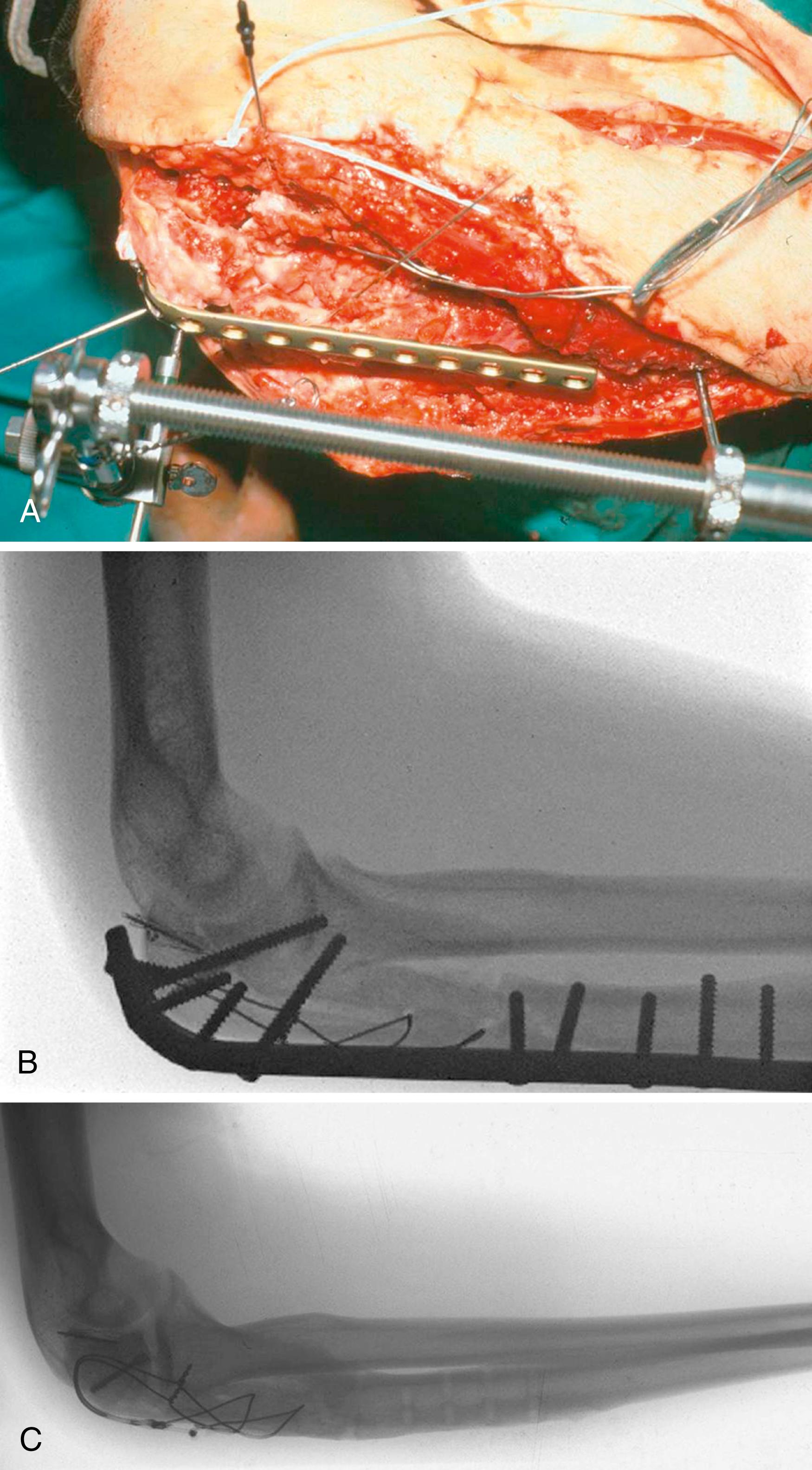

Apex posterior fracture-subluxations of the olecranon are typically associated with a fracture of the base of coronoid process, fracture of the radial head, and—in about 50%—avulsion of the lateral collateral ligament origin ( Fig. 20.8 ). Apex posterior injuries are often associated with osteoporosis, and the coronoid and radial head can be quite fragmented ( Case Studies 20.3, 20.4, 20.5, and 20.6 ).
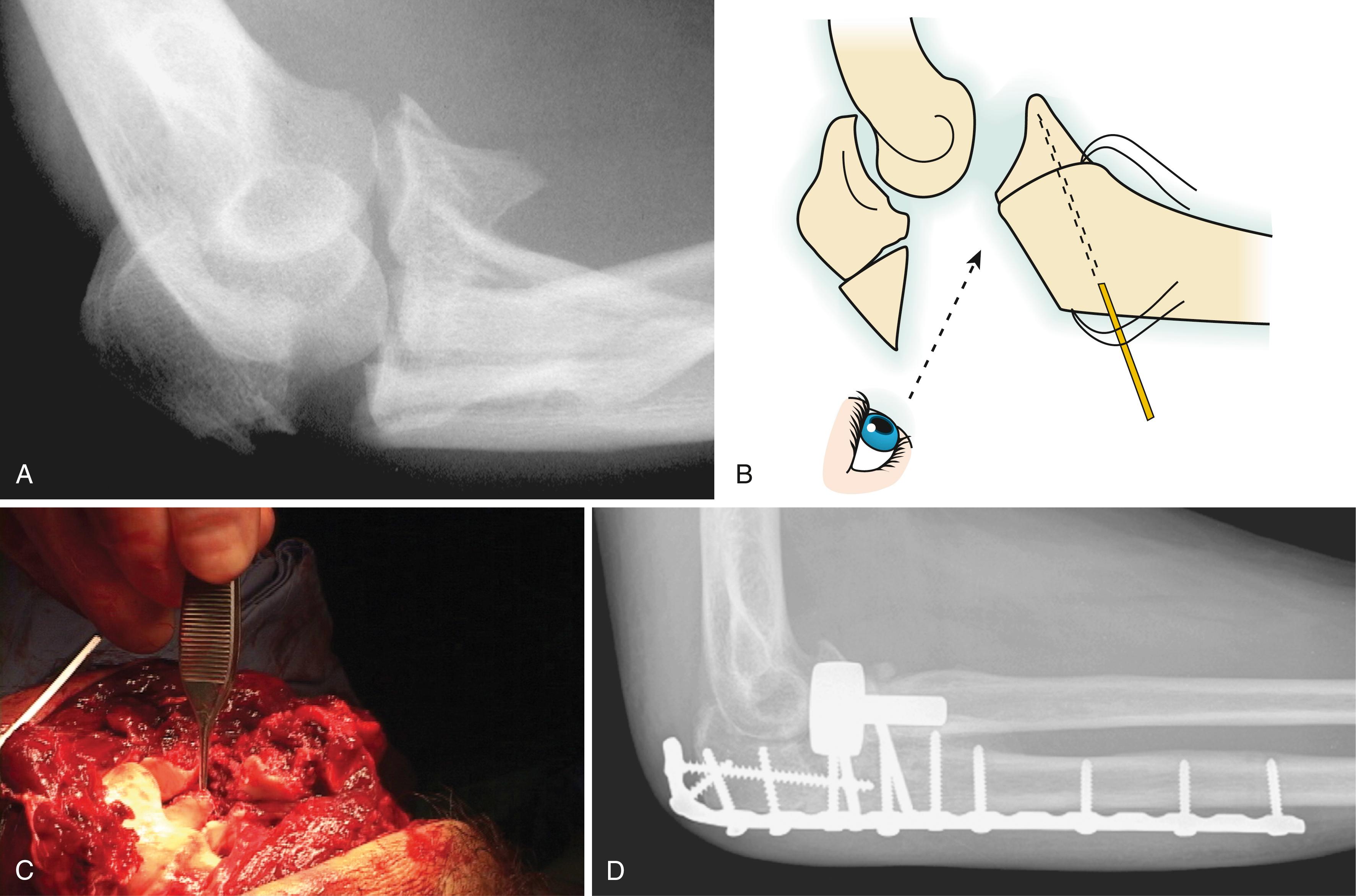
FLOAT NOT FOUND FLOAT NOT FOUND FLOAT NOT FOUND FLOAT NOT FOUND
A 45-year-old woman fell down the stairs, fracturing her elbow ( eFig. 20.7 ). FLOAT NOT FOUND
The coronoid was realigned and provisionally secured through the olecranon fracture. Definitive fixation was achieved with a precontoured plate (Acumed, Hillsboro, Oregon). The radial head was replaced with a prosthesis, and the lateral collateral ligament was reattached to the lateral epicondyle ( eFig. 20.8 ). FLOAT NOT FOUND
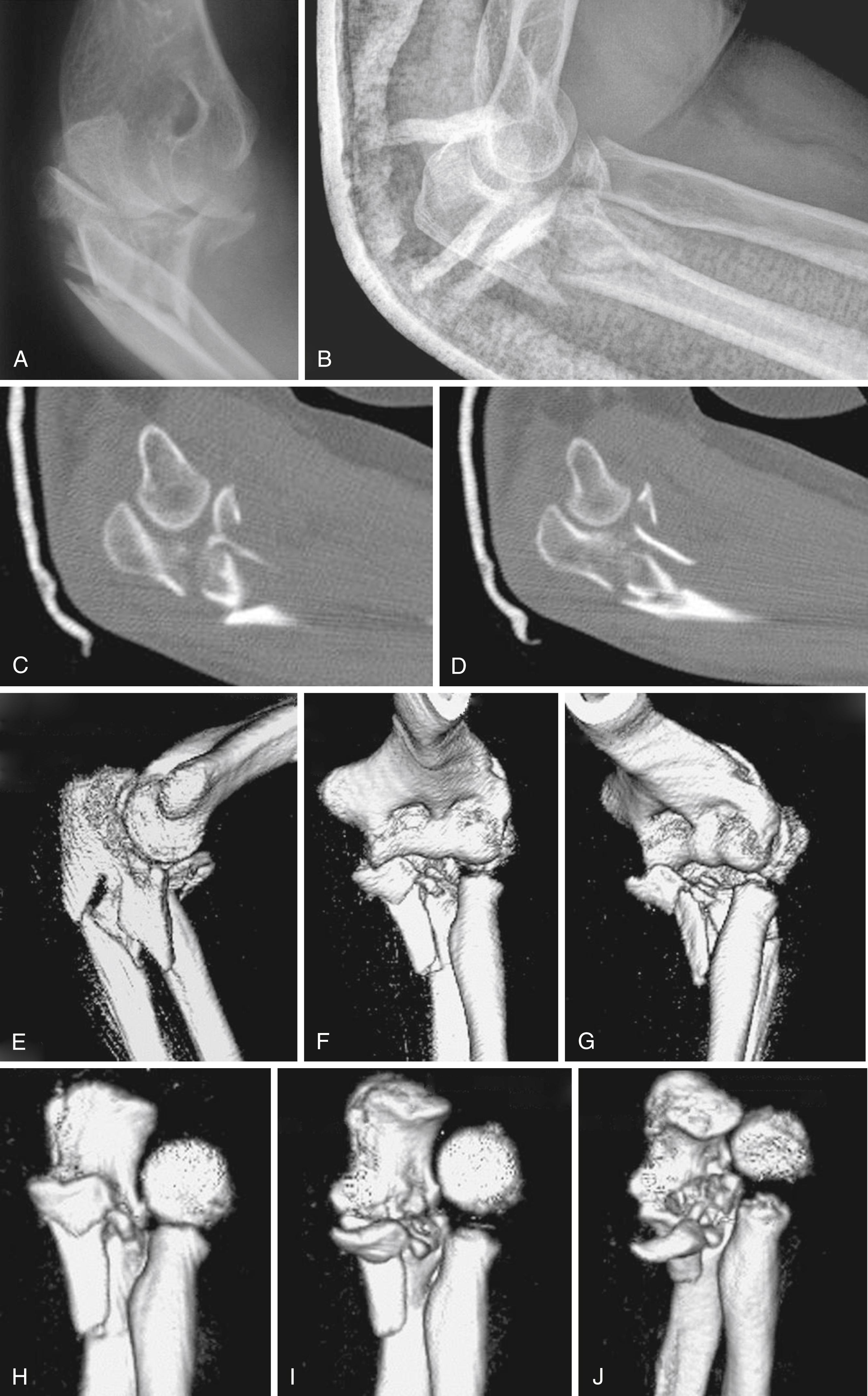
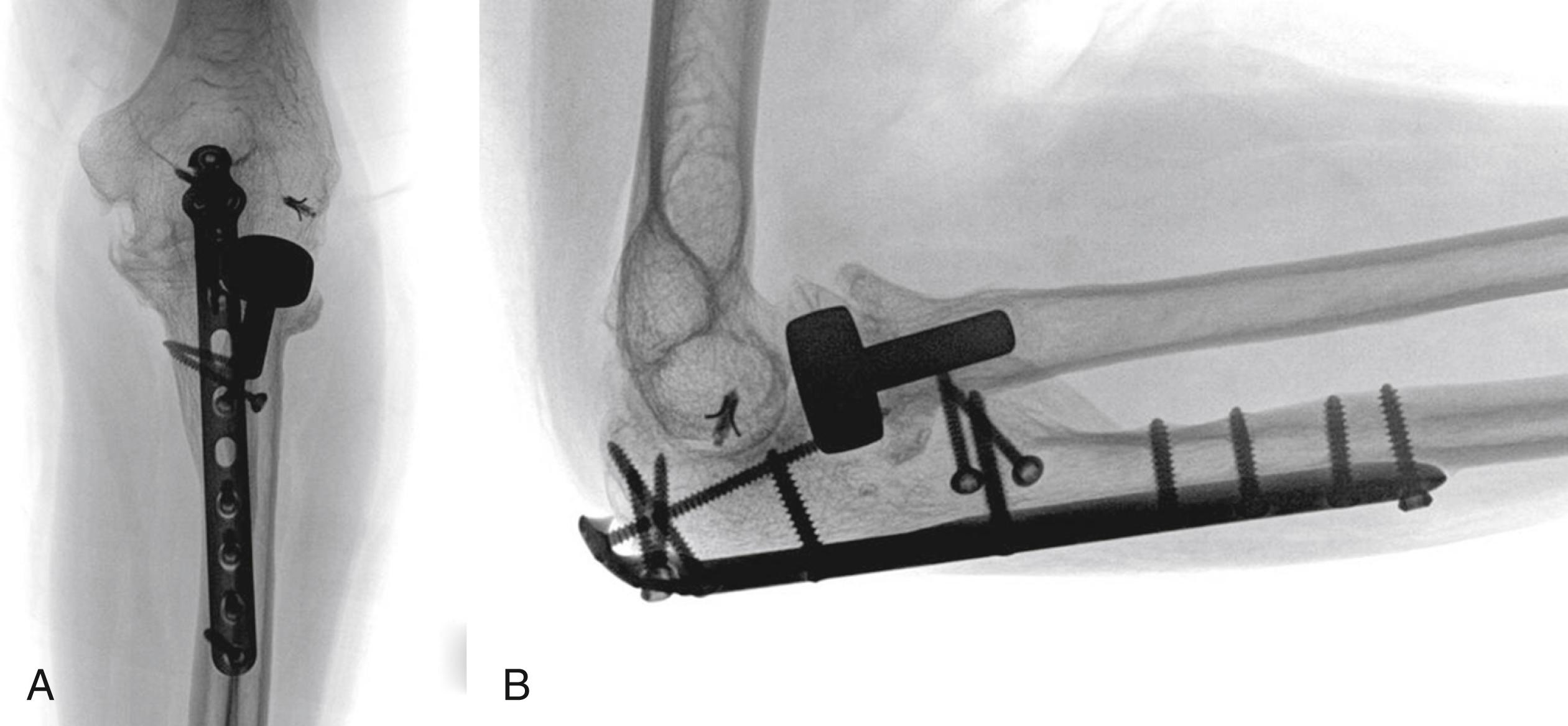
A 40-year-old man fell from a height ( eFig. 20.9 ). The coronoid was manipulated and reduced through the olecranon fracture, the proximal ulna was secured with a dorsal contoured plate and screws, the radial head was replaced with a prosthesis, and the lateral collateral ligament complex was reattached to the lateral epicondyle with a suture anchor ( eFig. 20.10 ). FLOAT NOT FOUND FLOAT NOT FOUND
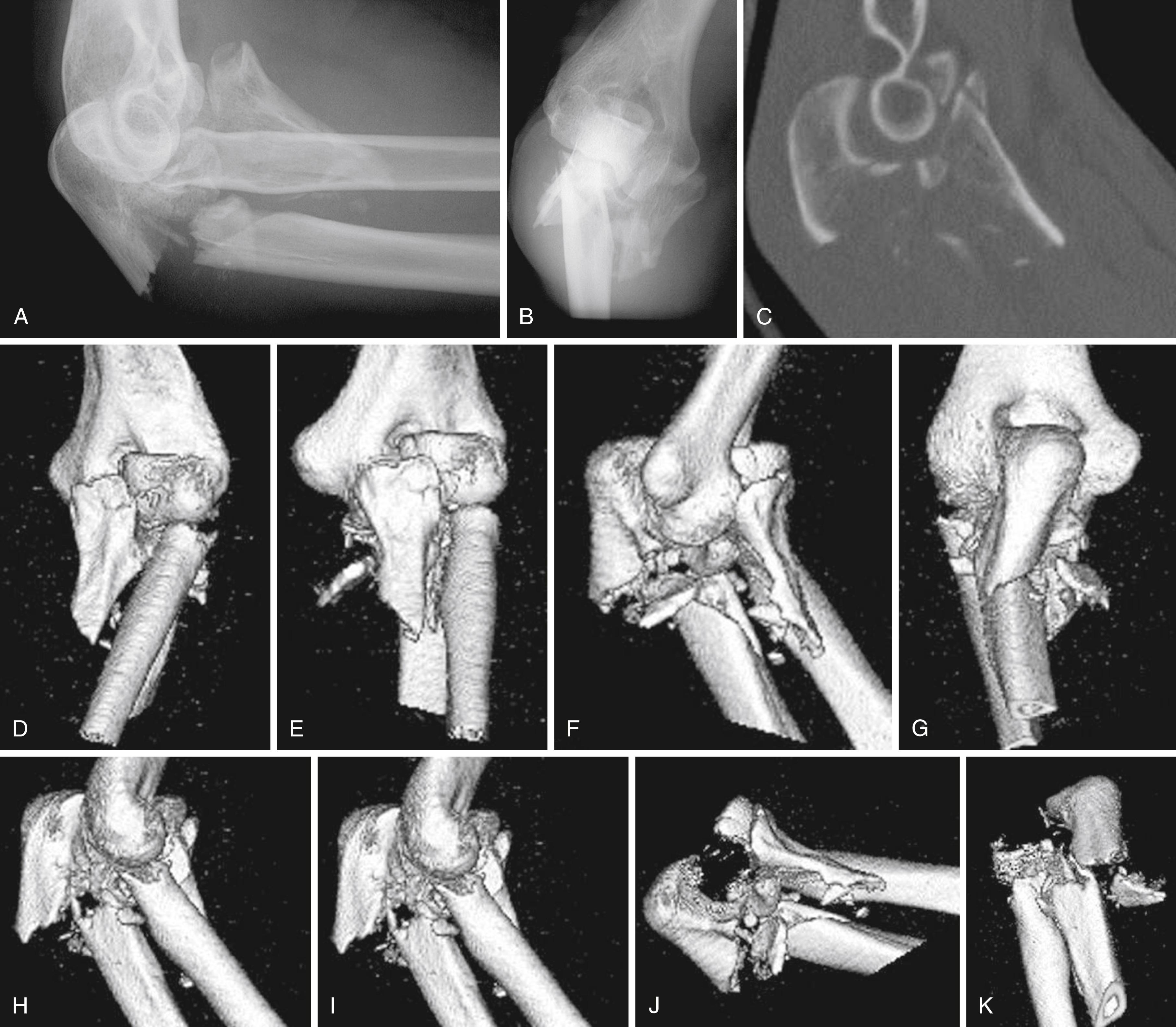
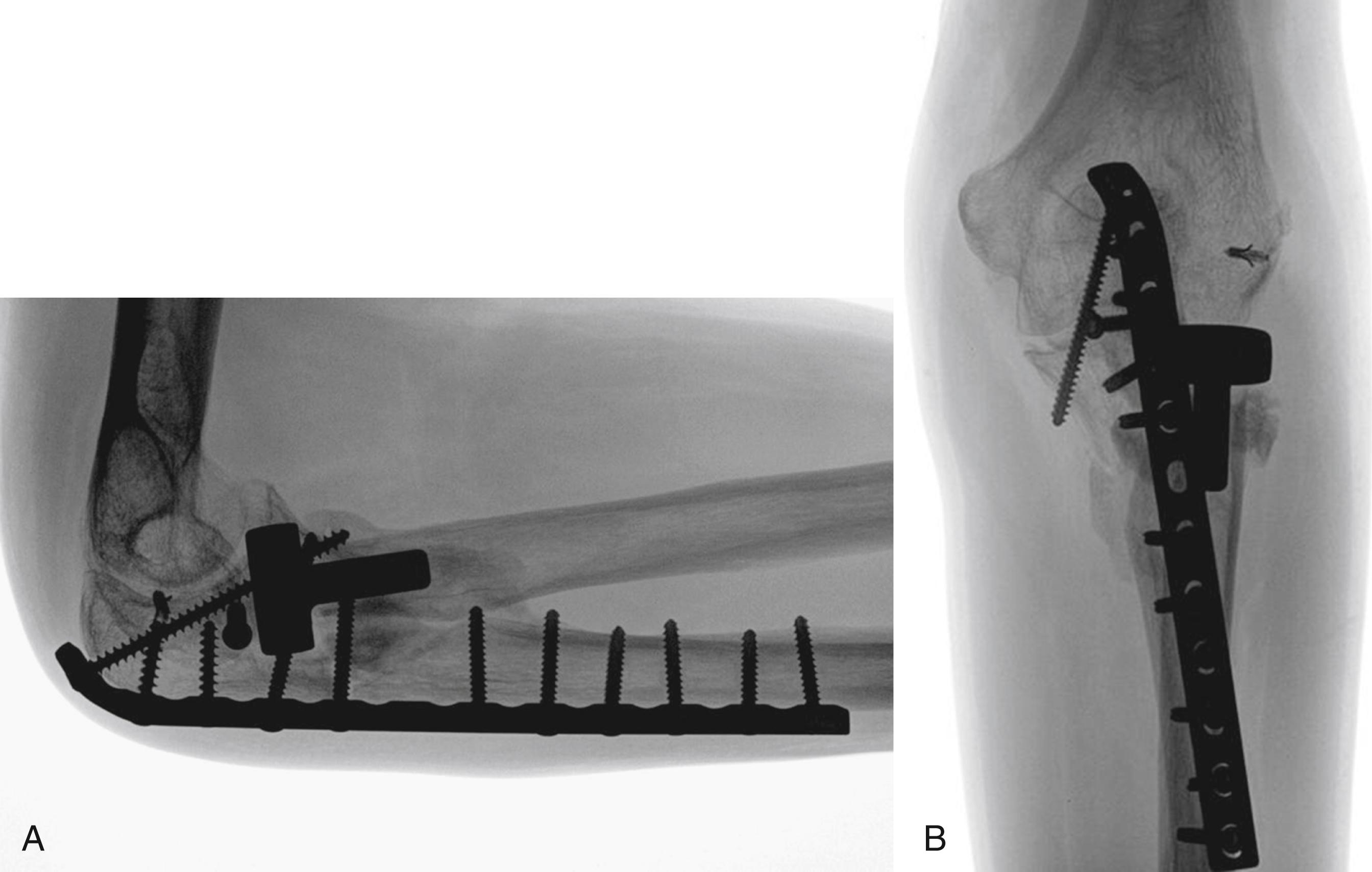
A 49-year-old woman fell down the stairs, sustaining a complex fracture-dislocation of the proximal ulna ( eFig. 20.11 ). FLOAT NOT FOUND
The surgical procedure is shown in eFig. 20.12 and the fixation and results in eFig. 20.13 . FLOAT NOT FOUND FLOAT NOT FOUND
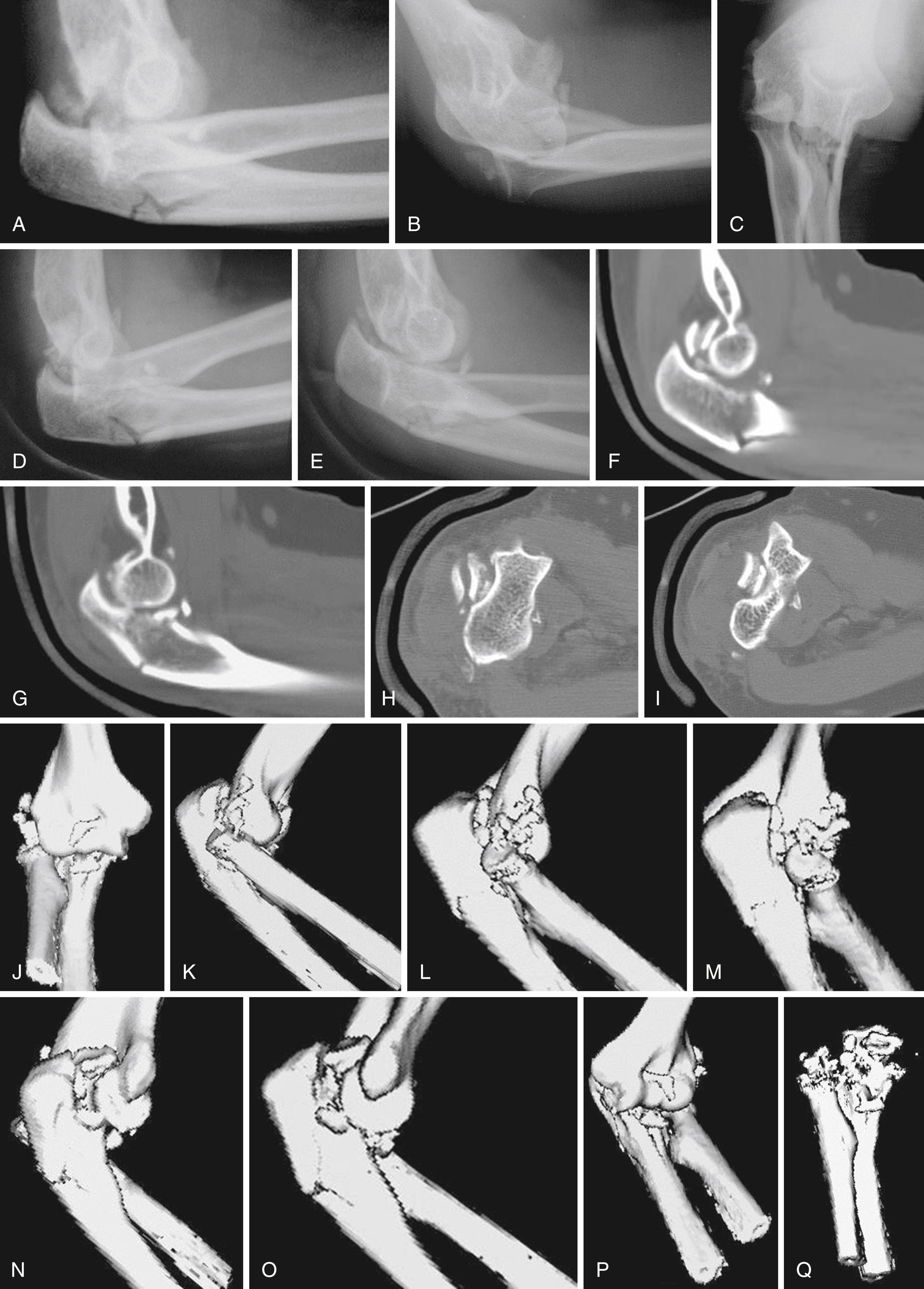

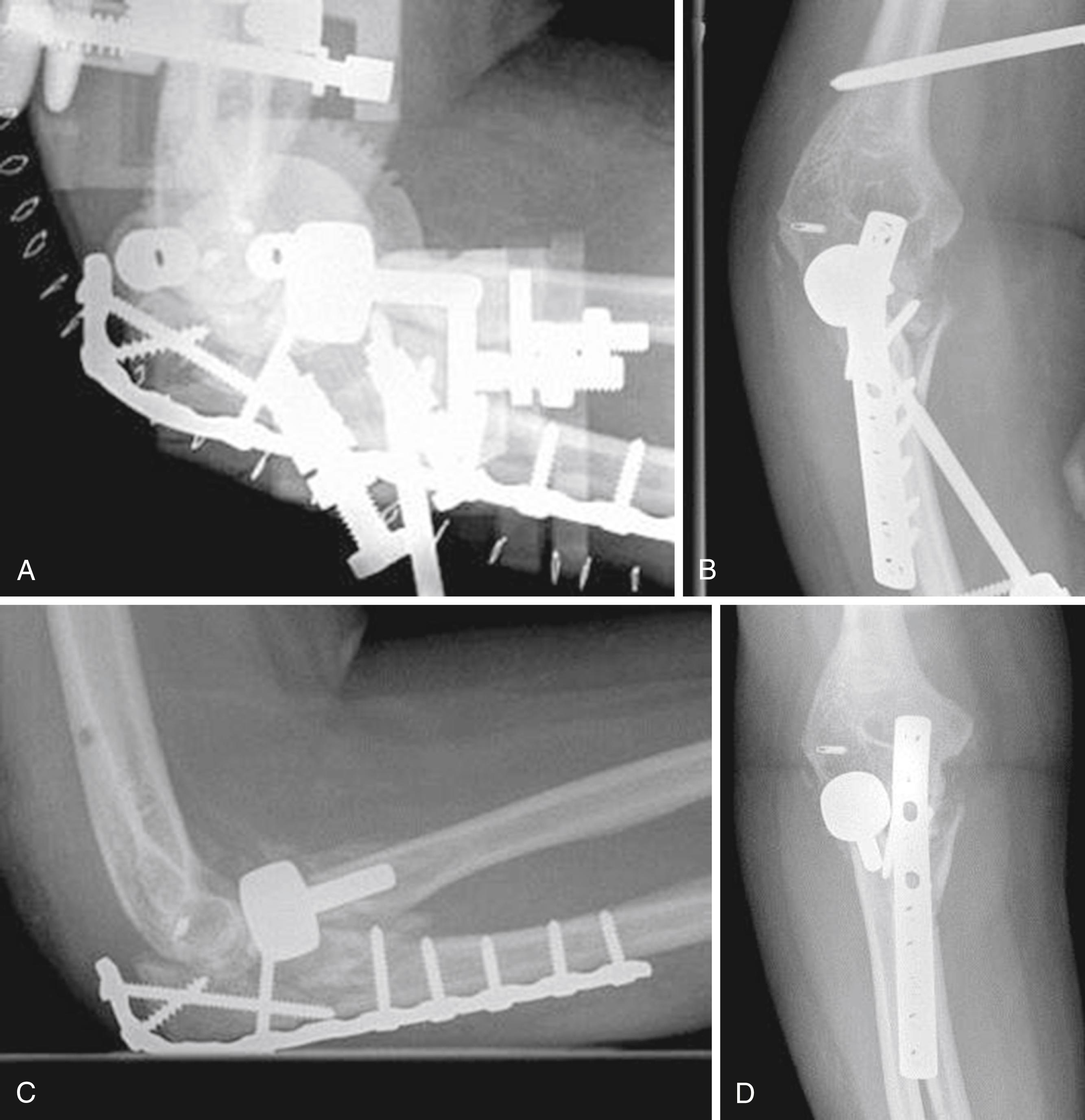
Radiographs of this injury are presented in eFig. 20.14 . FLOAT NOT FOUND
The surgical procedure is displayed in eFig. 20.15 , and the results are shown in eFig. 20.16 . FLOAT NOT FOUND FLOAT NOT FOUND
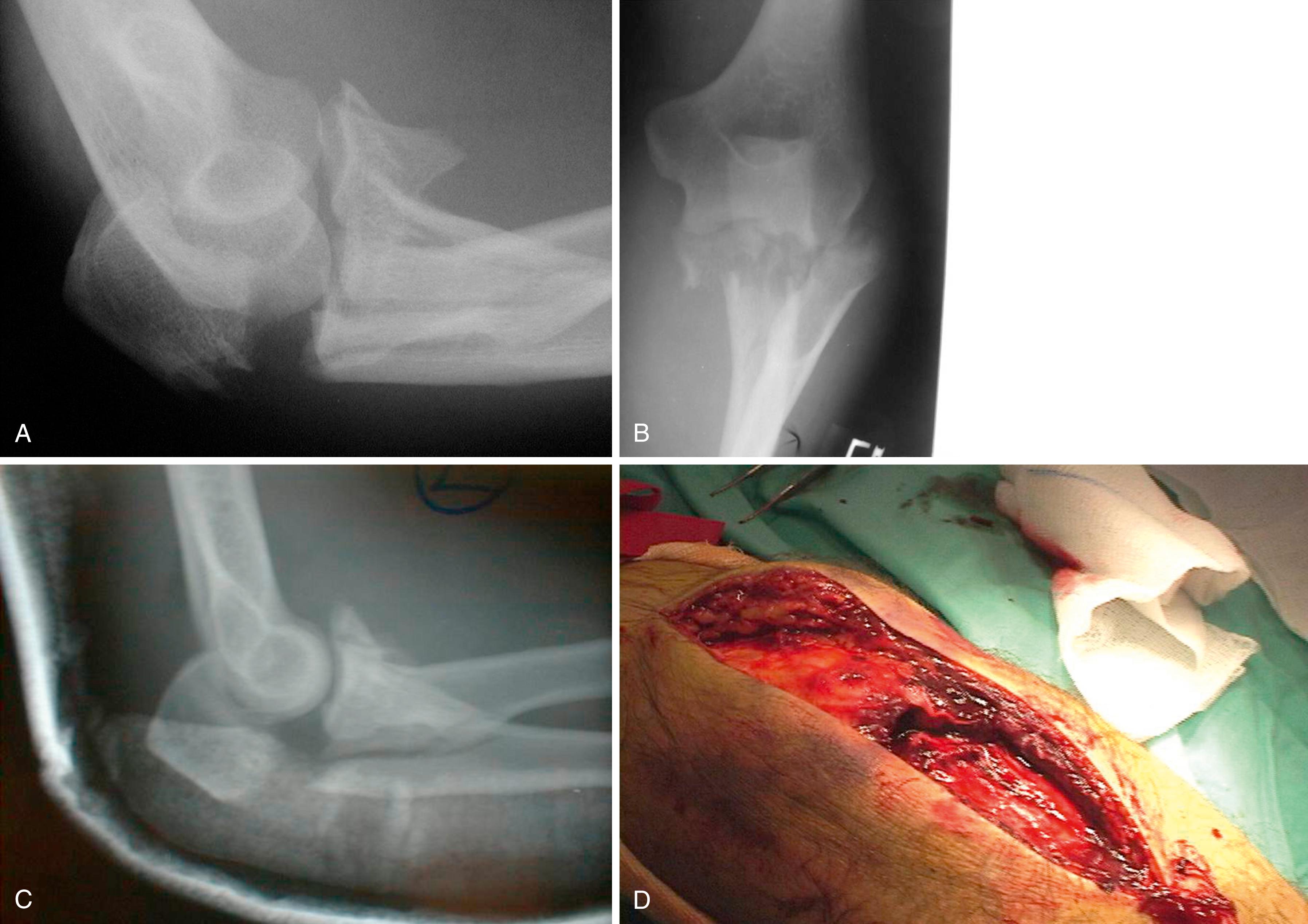
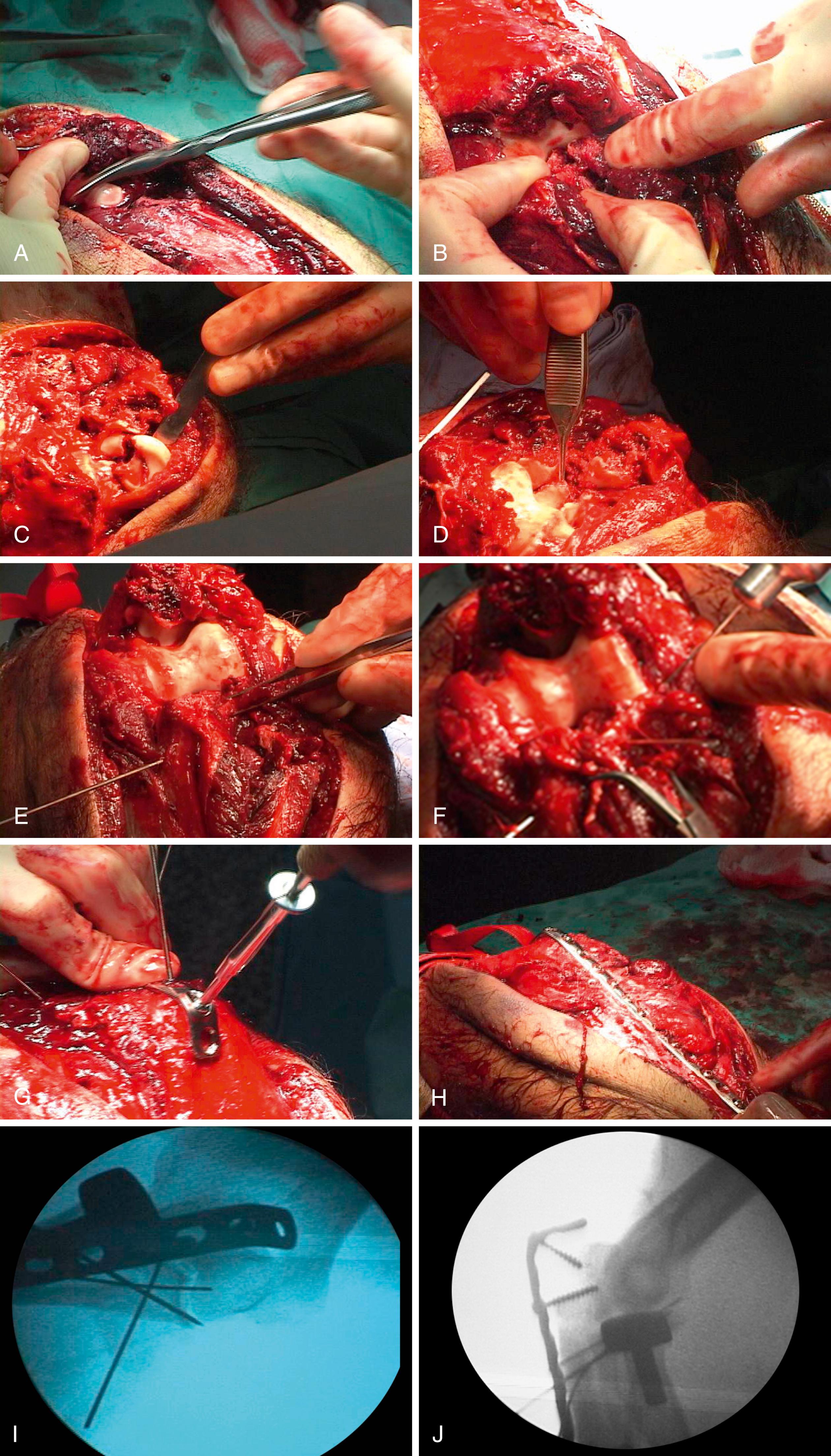
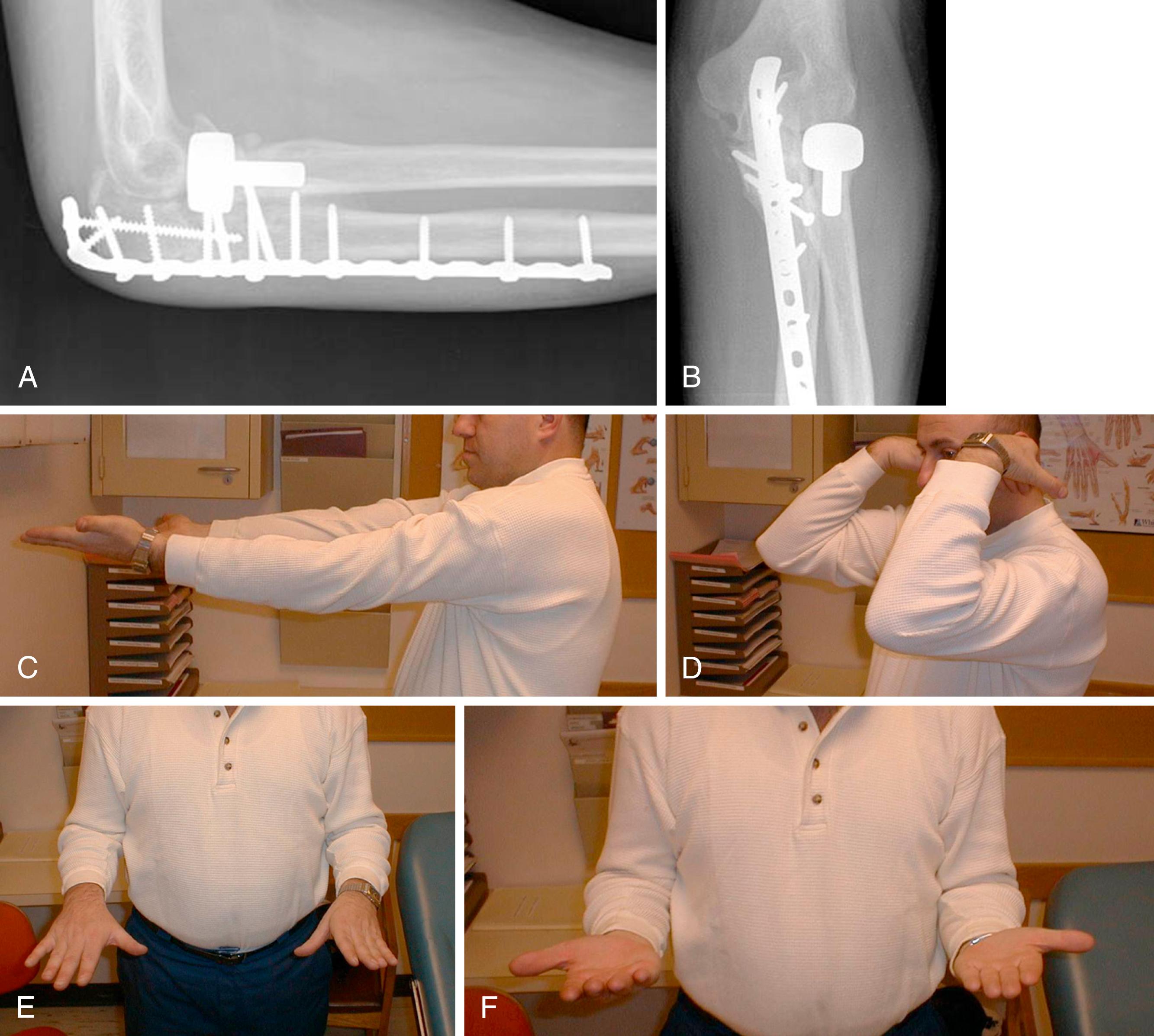
Some olecranon fracture-subluxations have varus alignment and result in a larger fracture of the coronoid than the ( Fig. 20.9 ) anteromedial facet of the coronoid process ( Case Study 20.7 ). These are typically associated with varus injuries. The radial head is nearly always intact in varus and anterior olecranon fracture-subluxations.
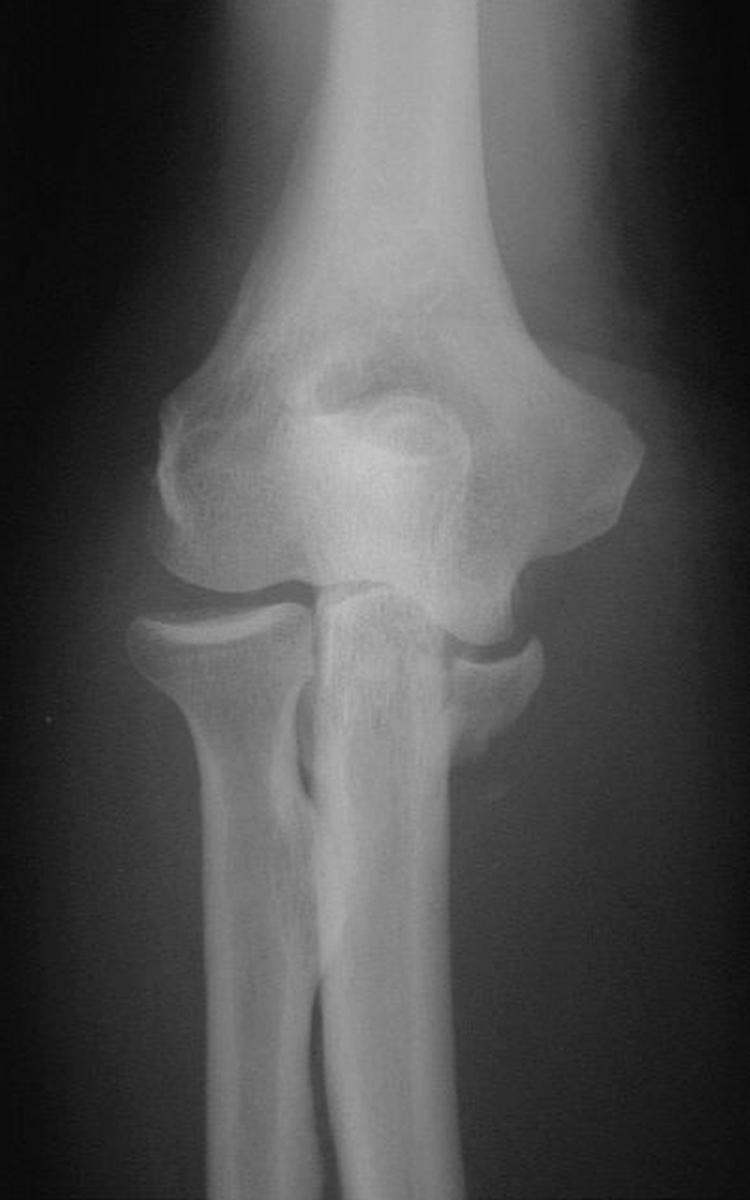
FLOAT NOT FOUND
See eFig. 20.17 for the exploration of diagnostic films, eFig. 20.18 for the operative procedure, and eFig. 20.19 for the surgical results. FLOAT NOT FOUND FLOAT NOT FOUND FLOAT NOT FOUND
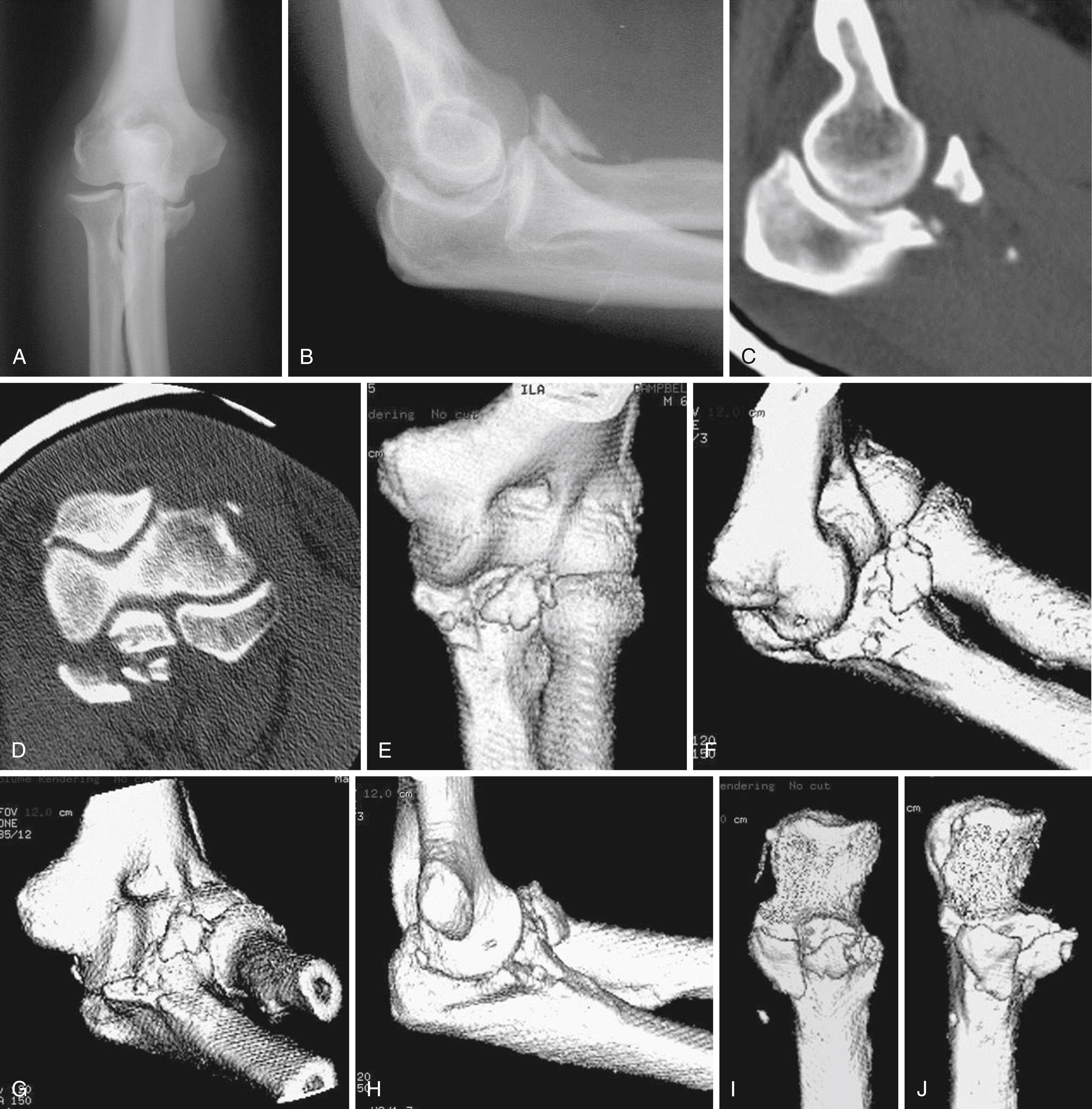

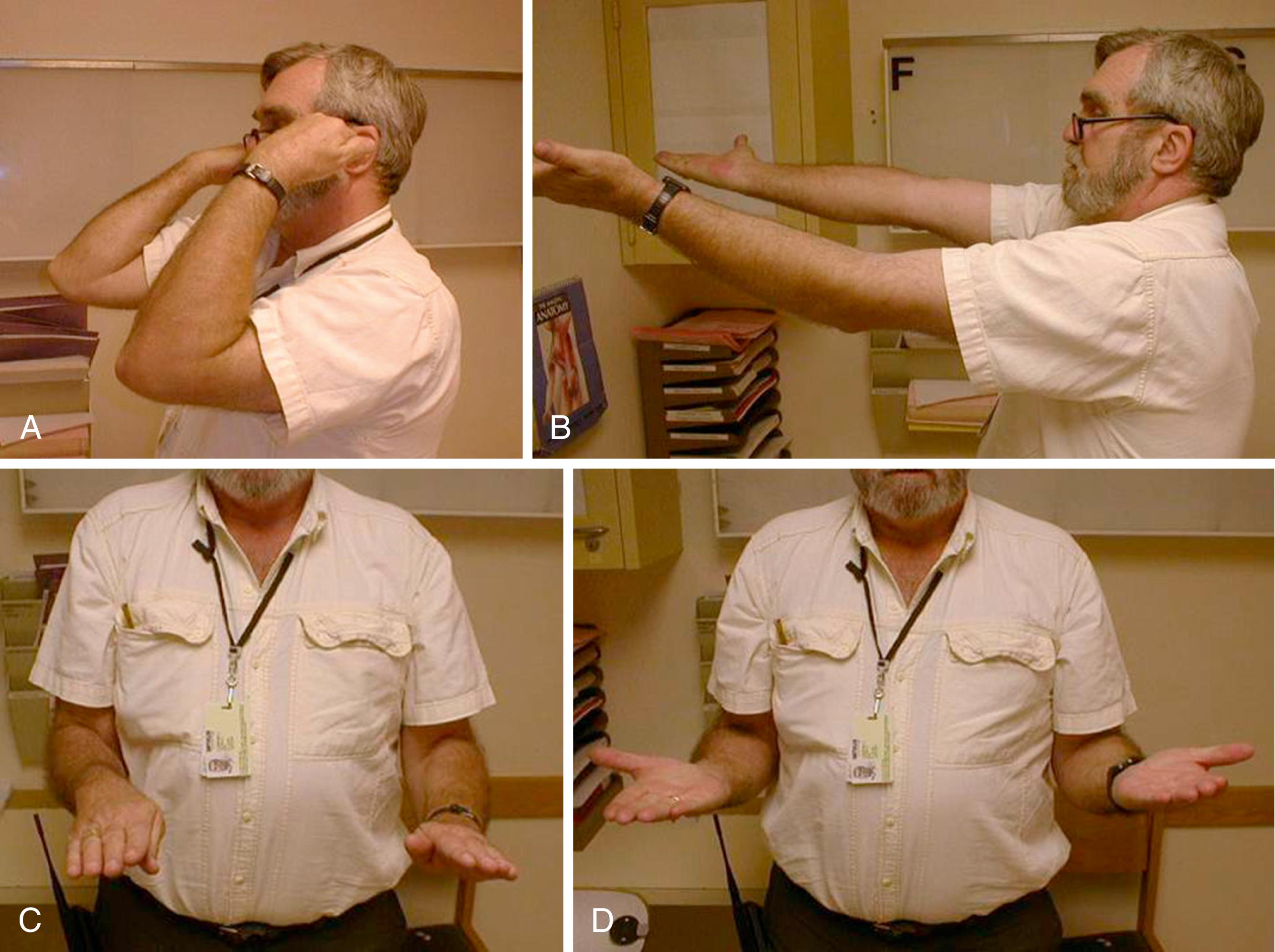
Nonoperative treatment of a displaced fracture of the olecranon process results in good motion, limited or no pain, and surprisingly reasonable elbow extension strength. , Infirm and less-active patients are best treated nonoperatively unless they might use the arm for transfers that need a strong triceps.
Operative treatment is appropriate for all healthy, active people and for all fracture-subluxations.
A midline posterior skin incision is routine. Traumatic wounds are incorporated. Some surgeons prefer that the incision not pass directly over the olecranon tip. However, a direct midline incision may cut fewer cutaneous nerves.
Nonfragmented, transverse olecranon fractures with no elbow subluxation can be treated with a screw, wires, or sutures oriented to convert the tensile forces associated with elbow extension into compressive forces across the fracture—an engineering principle known as the tension band ( Fig. 20.10A and Case Study 20.8 ). These fractures can also be repaired with a plate and screws ( Case Study 20.9 ). The results are comparable. The fixation doesn’t need to be particularly strong, and attention to limiting hardware prominence is helpful. Suture was long discouraged because it tends to slacken more than wires, but more recent suturing techniques may be acceptable, including use of suture anchors.
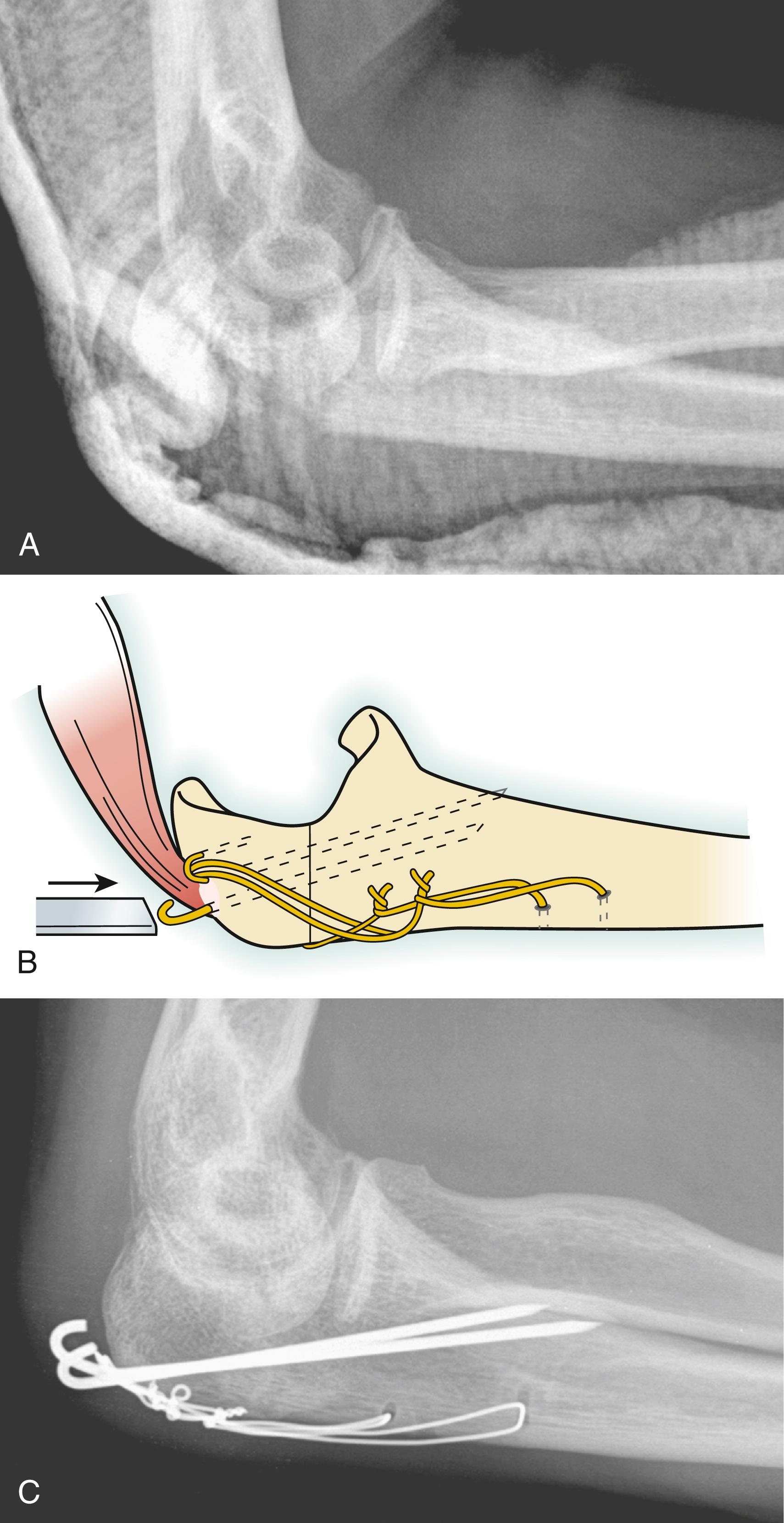
FLOAT NOT FOUND FLOAT NOT FOUND
The fracture is opened and hematoma removed to be sure that comminution and articular involvement are limited. The periosteum and muscular attachments are elevated slightly to visualize reduction of the fragment. A large tenaculum clamp can be used to maintain reduction of the olecranon. A hole drilled in the dorsal surface of the ulna can provide a good anchor point for the distal tine of the clamp.
Tension band wiring is suitable for simple fractures without fracture of the radial head or coronoid or dislocation/subluxation of the ulnohumeral joint ( eFig. 20.20 ). FLOAT NOT FOUND
The surgical procedure is displayed in eFig. 20.21 , and the results are shown in eFig. 20.22 . FLOAT NOT FOUND FLOAT NOT FOUND
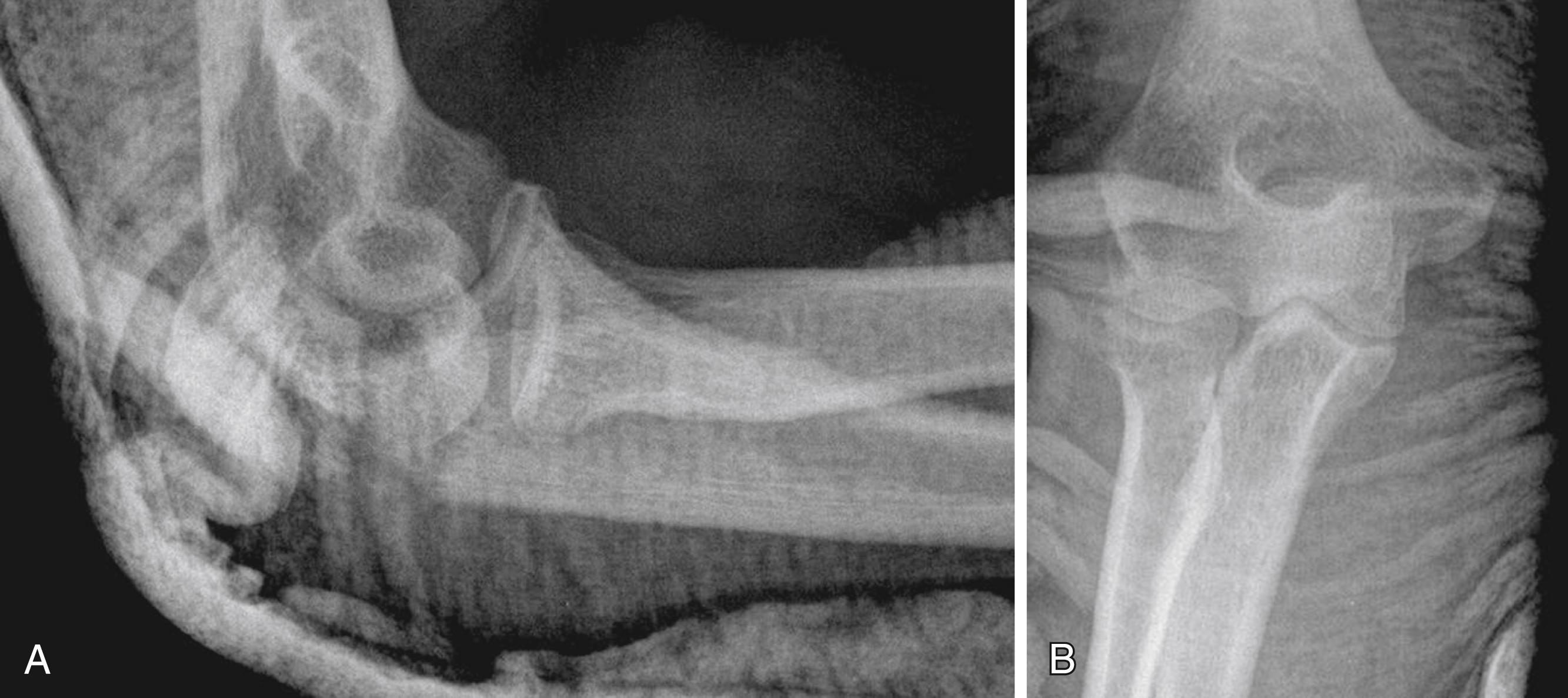
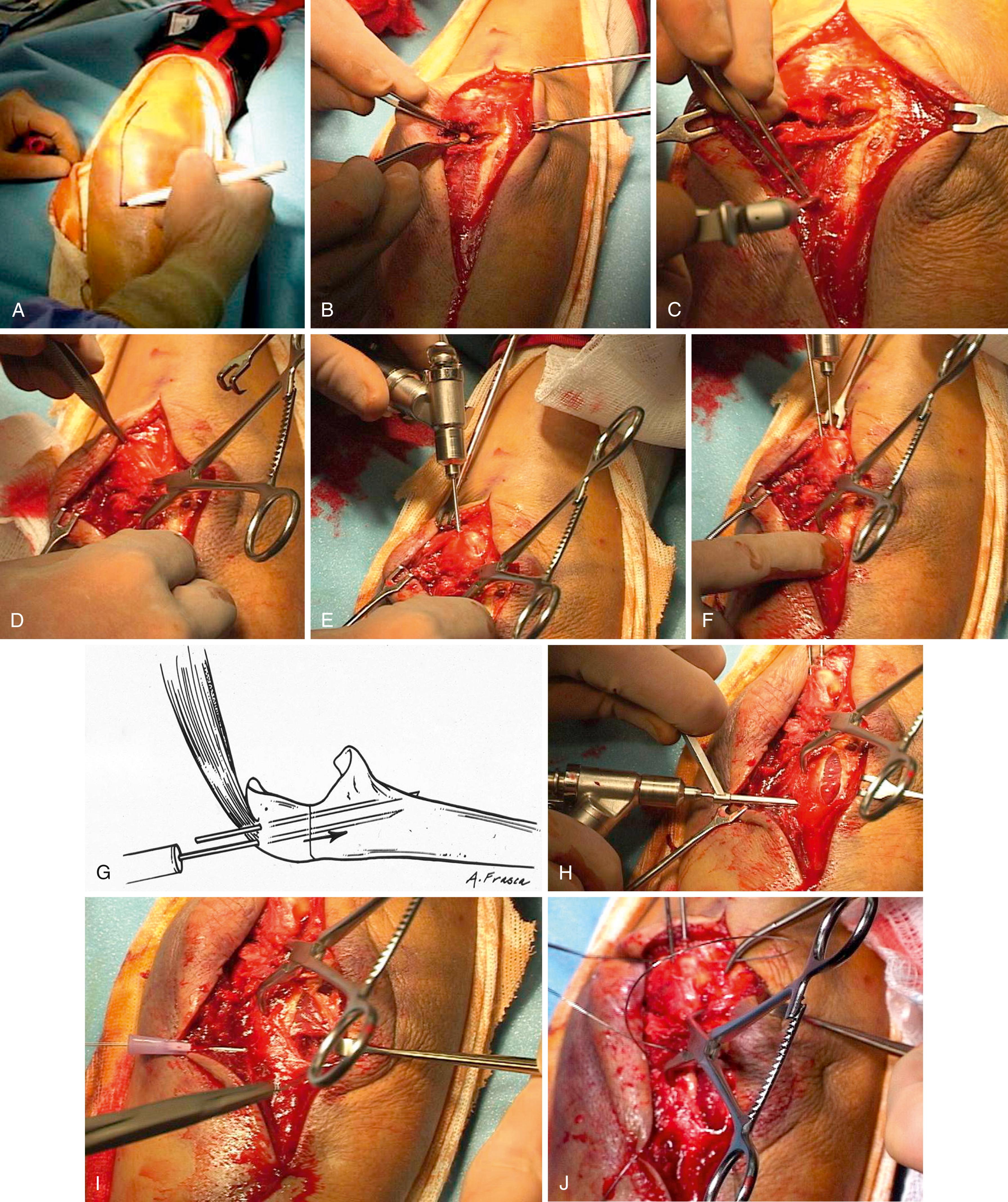
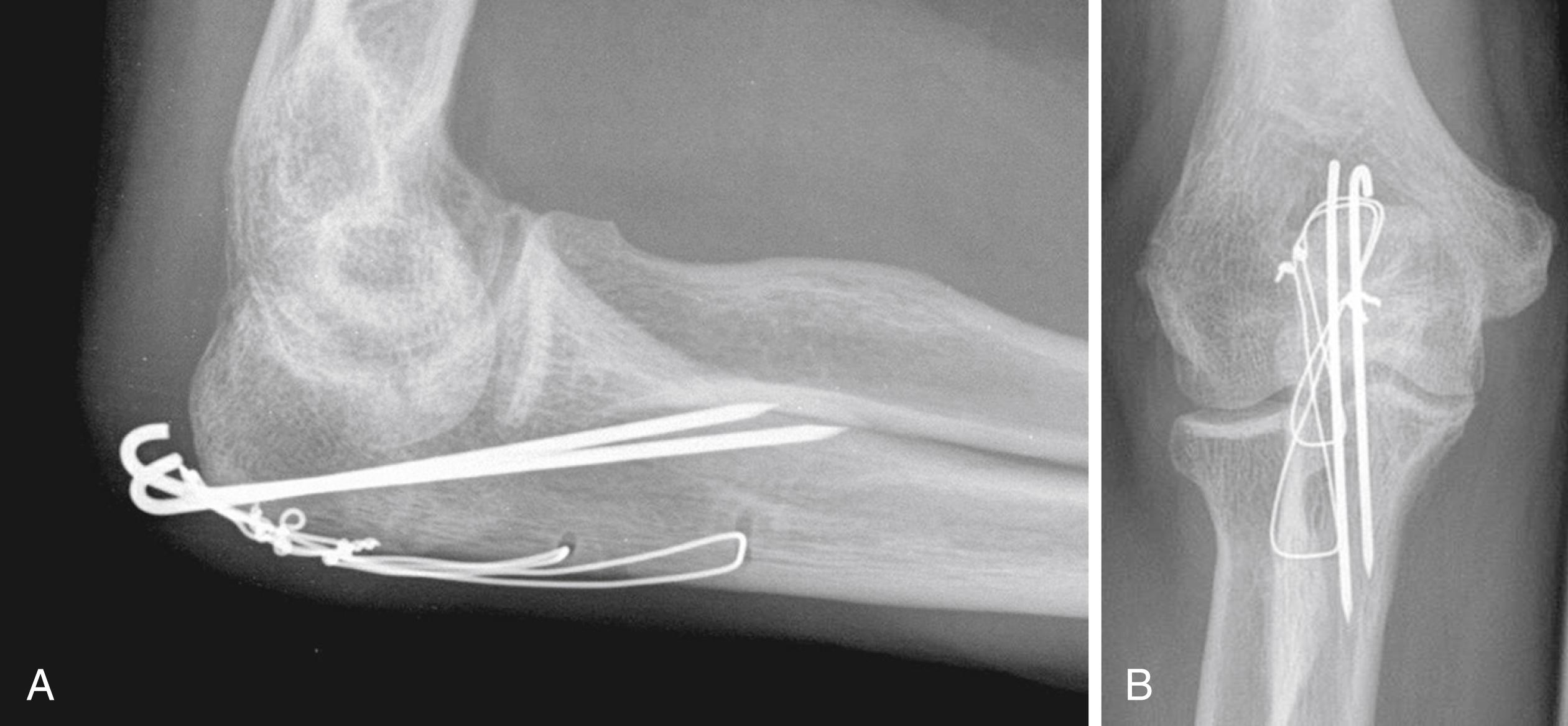
A 35-year-old woman suffers a comminuted fracture of the olecranon without associated fractures or dislocations ( eFig. 20.23 ). FLOAT NOT FOUND
The fracture was treated with plate fixation ( eFig. 20.24 ). FLOAT NOT FOUND
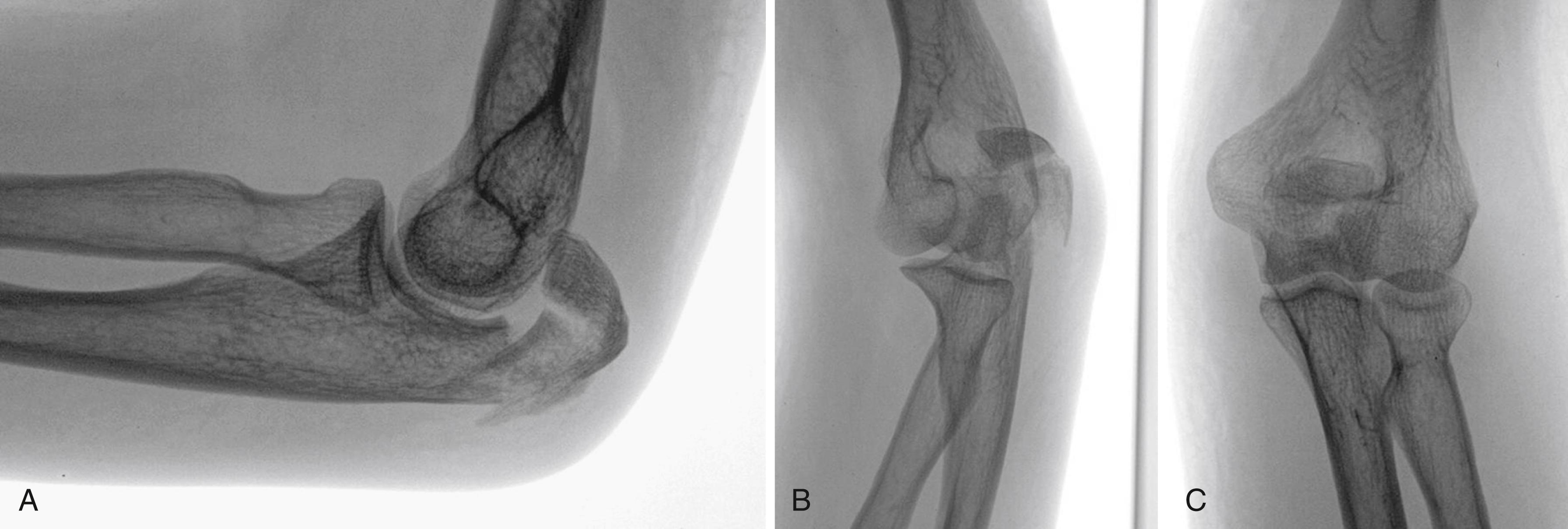
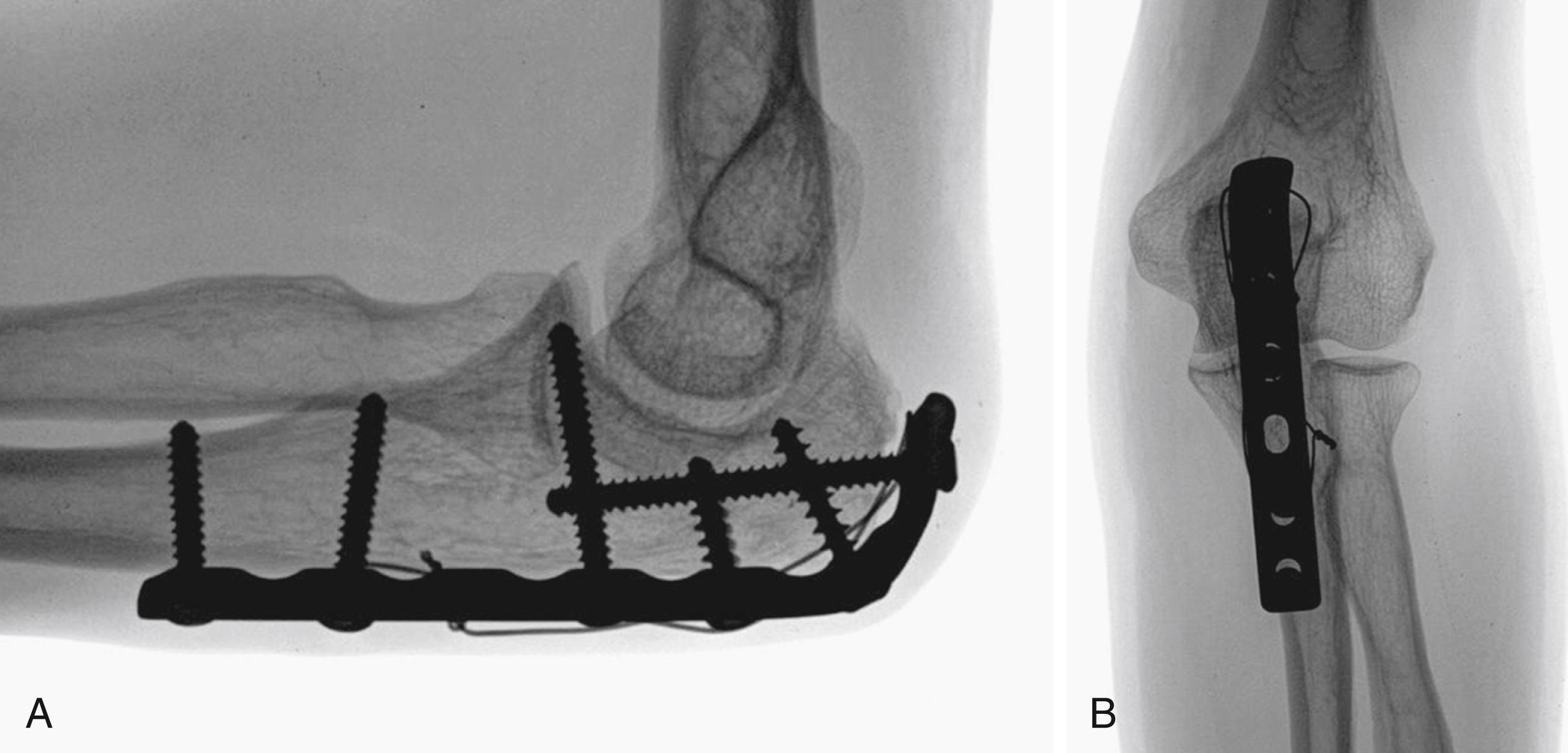
Two parallel Kirschner wires are drilled across the fracture site. The majority of surgeons use 0.062-inch wires, but we have used 0.045-inch wires, and our experience and data show comparable results. The wires can be drilled parallel to the ulnar diaphysis or obliquely so that they pass through the anterior ulnar cortex, just distal to the coronoid process, , which is thought to limit the potential for wire migration. For the latter technique, after exiting the anterior cortex, the wires are retracted from 5 to 10 mm, anticipating subsequent impaction of the wires into the olecranon process proximally.
Distal to the transition from the flat proximal ulna to the apex posterior triangular shape of the diaphysis, the extensor carpi ulnaris and flexor carpi ulnaris muscles are partly elevated to allow creation of 2.0- or 2.5-mm drill holes to pass suture or wire. Many surgeons use a single 18-gauge stainless steel wire for the tension wire, but we prefer to use two 22-gauge stainless steel wires, each passed through its own drill hole distally. The smaller wires are less prominent. An alternative is a size 5 metric sternal wire of the type used in cardiac surgery, which is approximately the same gauge as a 23-gauge wire and comes swaged to a large cutting needle. This facilitates passage through bone tunnels and through the triceps tendon.
Simple, nonfragmented fracture
No subluxation of the elbow or associated fractures
Location of the fracture at or proximal to the midpoint of the olecranon fossa
Anteroposterior and lateral radiographs of the elbow
Become a Clinical Tree membership for Full access and enjoy Unlimited articles
If you are a member. Log in here